
HECTOR'S BEET MUFFINS
04/02/20 — Ada Broussard
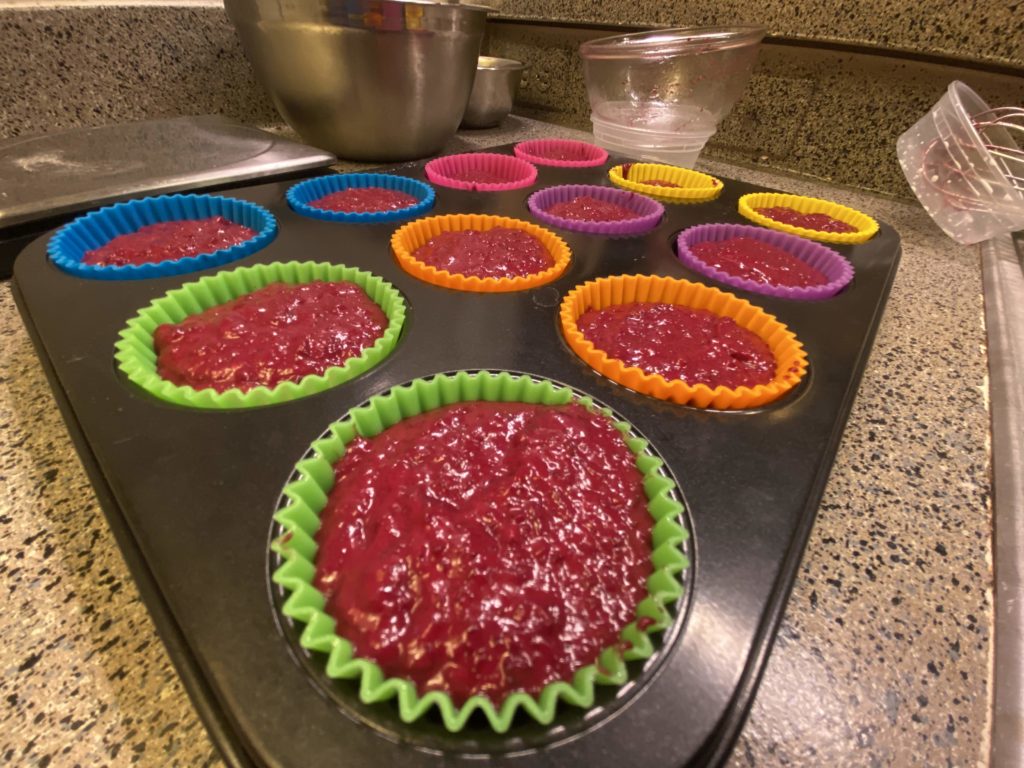
Recipe and Photos by: Héctor González Mexican at large Abuelita Profesional
JBG's beet season is one of my favorite things. I have roasted, grilled, juiced and even made beet ketchup with this taproot. However, one of my favorite recipes is beet muffins. It started with the simple premise of baking with beets, using these the same way as carrots for a cake. After playing with the recipe, roasting the beets, then turning these into a mush. Usually 2 medium beets will produce enough mash for a good dozen.
Beet Muffins
- Ingredients
- 250 g beets, shredded or mashed with a food processor or blender
- 200 g all purpose flour (You can mix with whole wheat flour, if you want)
- 100 g brown sugar
- 120 ml vegetable oil
- 120 ml liquid (you can use soy, almond, coconut, oats or any milk if desired)
- 5 g baking powder
- 5 g baking soda
- 5 ml pure vanilla extract
- 10 ml apple cider vinegar
- 2 g tsp. cinnamon
- 2 g tsp. ginger
- 1 pinch of salt
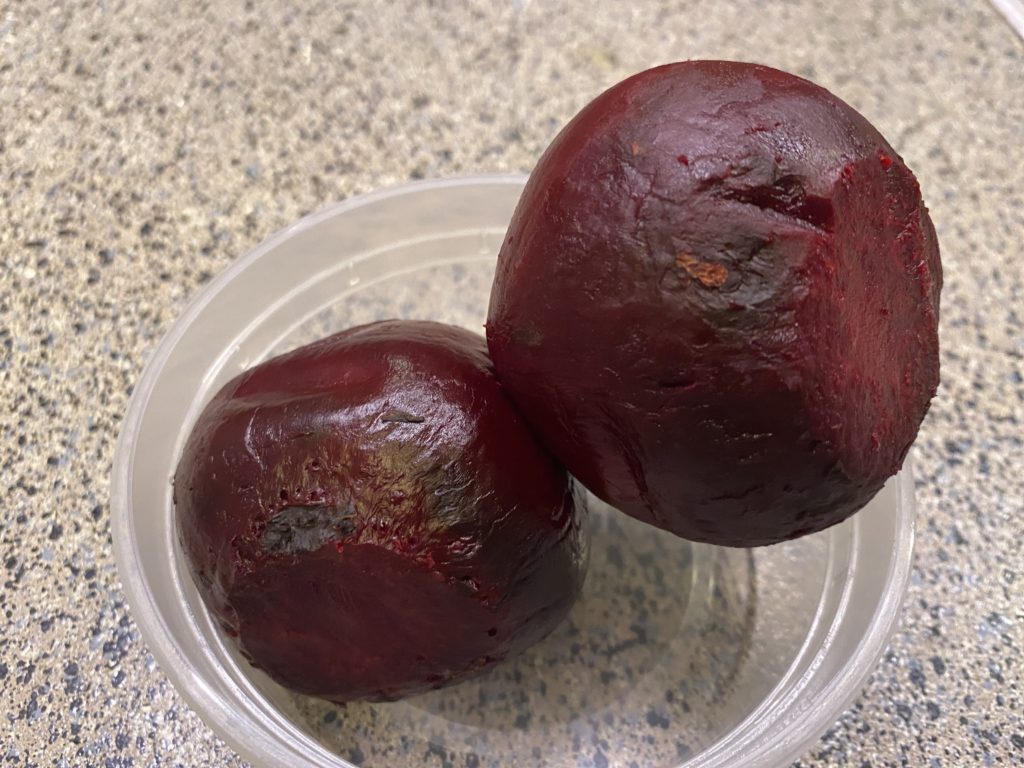
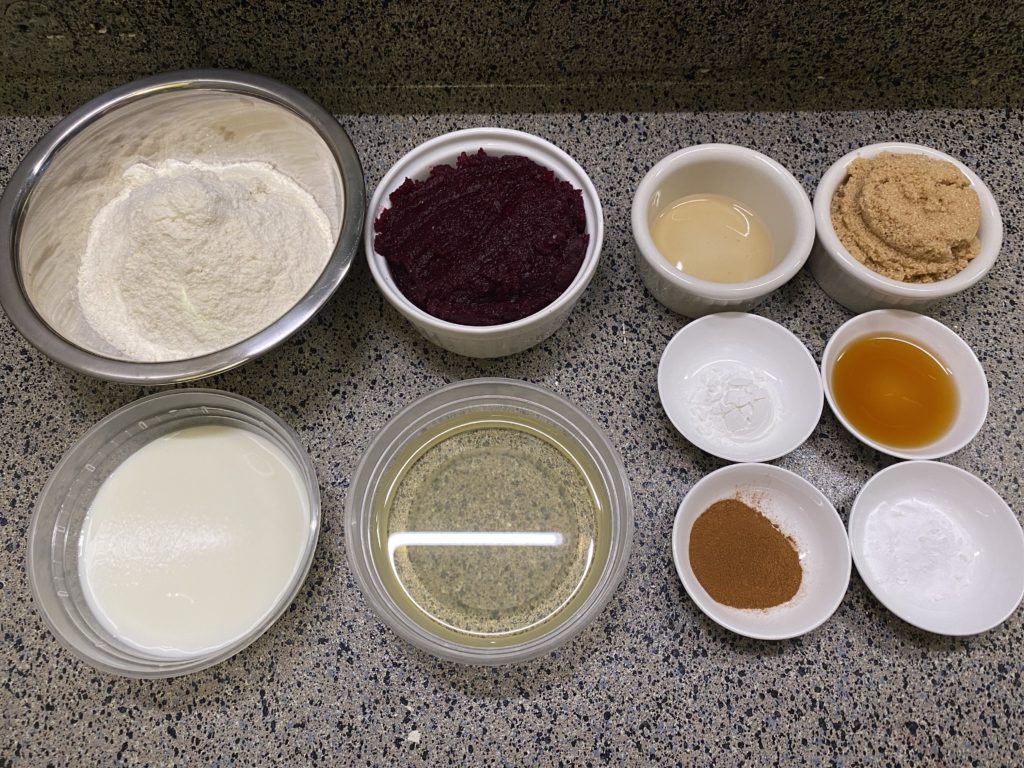

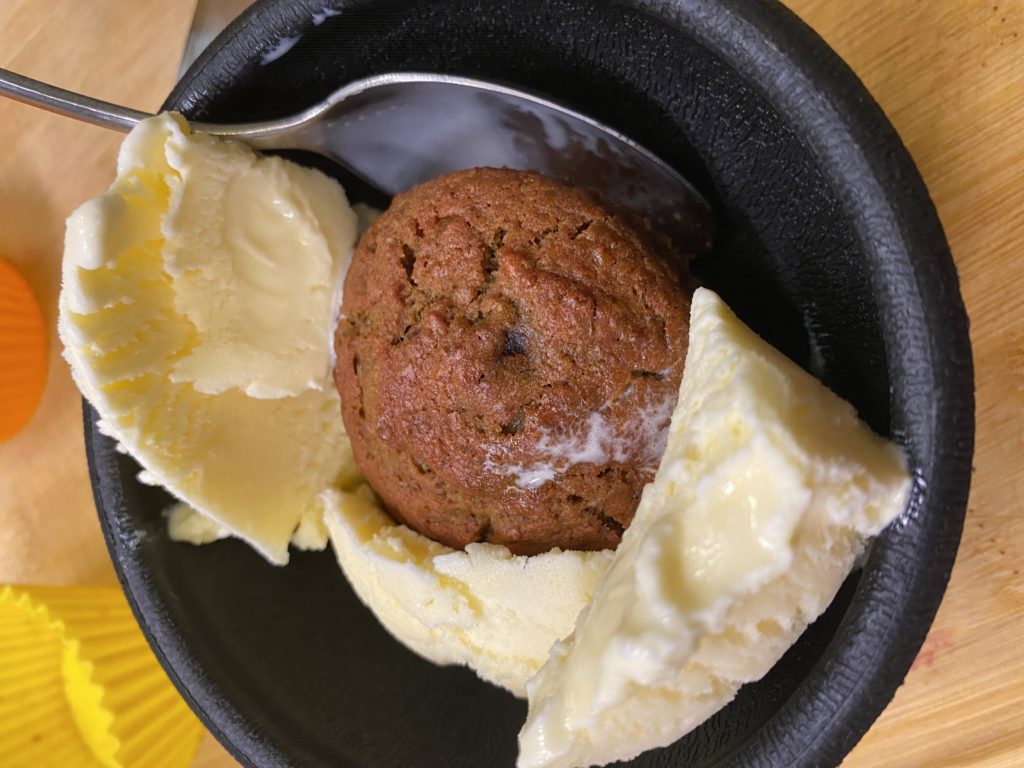
HERBY CHICKPEA SALAD
04/02/20 — Ada Broussard
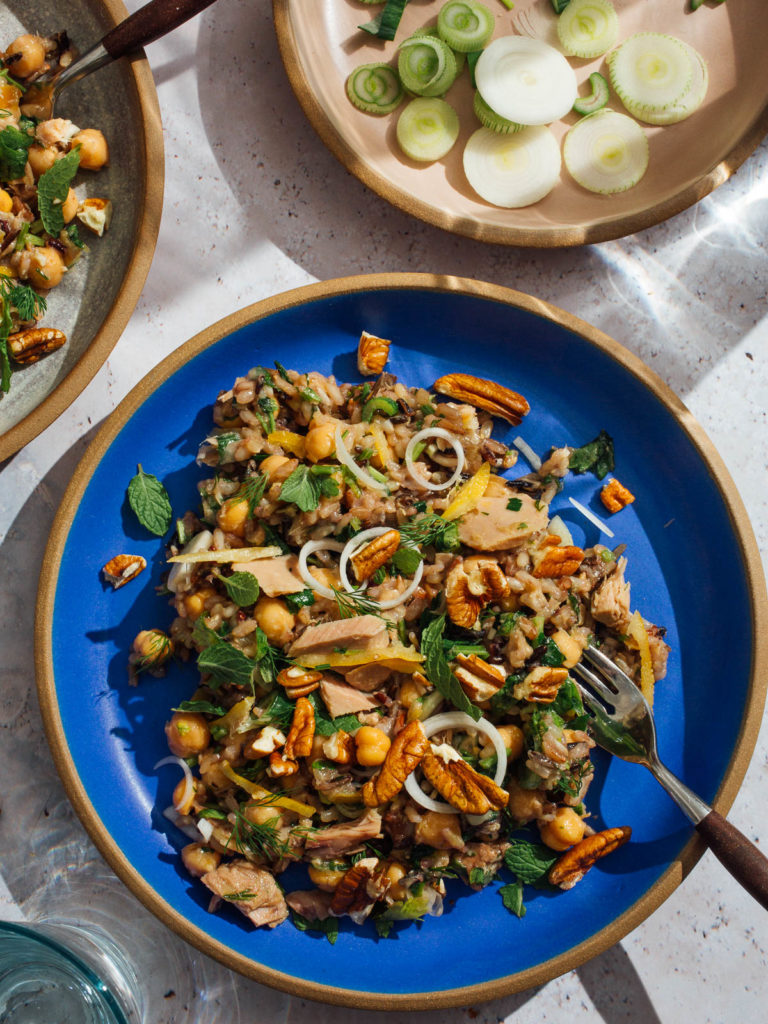
Recipe and photo by Mackenzie Smith
Our almost-20-month-old toddler and lazy pit bull pup are both having the time of their lives as my husband and I scramble to figure out this new rhythm of working two full-time jobs from home while also caring for a really cute tiny dictator. The first week of self isolation was a total mess, even with gratitude for our health and employment top of mind. It just didn’t feel like we had enough time to give to our jobs and to Maya and to whatever needed to get done around the house — or that we had anything to actually complain about, all things considered. We are swimming in privilege over here, and that is not lost on me.
Still, I am tired.
Week two has been more manageable, though I do not see any time-intensive cooking projects happening for us in the near future. My goal is to make sure everything in our CSA is consumed, and that we all enjoy 3 square meals a day. This herby grain salad with spring onion, chickpea and tinned smoked trout comes together really quickly, and makes for a solid lunch at the computer.
The beauty of spring onions is that they are so sweet and mild that they act as much like a punchy green herb as they do an allium, and this grain salad really lets them shine. I used wild rice in the photo, but this recipe works just as well with quinoa, farro or orzo. Tinned fish is a nice addition, but also completely omit-able. Roasted vegetables always welcome. I love serving this bulky grain salad on a bed of fresh dandelion greens or spicy arugula. Feta cheese never hurt a grain salad, though none made it into this photo. Use what you have and make it fashion!
- 1/3 cup olive oil
- 1 clove grated garlic
- 1/2 a preserved lemon, seeds removed and chopped (or juice and zest from one whole lemon)*
- 1/3 cup very finely chopped fresh dill
- 1 bunch parsley (stems included), finely chopped, divided in two
- If using fresh lemons, add about 1/4 teaspoon salt
- 1 large can of chickpeas, drained
- 1 can smoked trout, forked into pieces and any bones removed
- 1-2 cups wild rice, ideally cooled ahead of time
- 1 large or two small spring onions, both green and white parts sliced into circles
- salt to taste
- a handful of fresh mint leaves
- 1/3 cup chopped toasted pecans
In a large mixing bowl, combine olive oil, grated garlic, lemon, dill, 1/2 of your chopped parsley, and salt (don’t add salt if using preserved lemon). Add chickpeas and tinned fish (and roasted veg if you have), then your cooked grains. Stir in onions and the rest of your parsley. Taste, and season with salt and pepper as necessary. Top with toasted pecans, fresh mint leaves and any other accouterments that will bring joy to your salad. Count your blessings!
FIRST FRIDAY STAFF PICKS: APRIL 2020 EDITION
04/03/20 — Ada Broussard
In case it hasn't been on your radar, we publish this fabulous staff-favorite-centric post every first Friday of the month! We thought it deserved a highlight since it's one of our long-time favorites and definitely a skim-worthy feature if you're in the market for new ideas and inspiration. Ever wonder what your local farmers do off the fields? Cue: FIRST FRIDAY STAFF PICKS!
We think that our staff is the best in the business (okay, okay, we are a little biased), but the JBG family hails from all over the place and covers the gamut in talents and interests. We love sharing events, adventures, and side projects that inspire and excite our JBG-ers (food-related or not) with the community. Check out the staff-curated list of favorites below!
Matt:
This and this video are my pick. (The Lukas Nelson video was shot while in quarantine and couldn't be more timely! We love it!
The Farm:
Times like these require quick, thoughtful, and creative solutions, and we are astounded at our community's response to COVID-19. There are so many people doing their absolute best to keep folks fed, entertained, and the community healthy.When the farm suddenly needed hand sanitizer to give to our drivers and market staff, many of our social media followers and CSA members donated some of their own. Several companies like Zilker Brewing and Tiny Tails to You also donated some of their extra bottles.
Speaking of Tails, these long-time partners of ours are suddenly unable to host their usual parties. But you know what they can do? Virtual Animal Programming. Yep. Here are some of your options for getting an animal fix, over the interweb:
- Book a Virtual Animal Program – One-on-one and group interactive educational experiences for children and even adults.
- Pay it forward – Sponsor programming for people in need.
- On Wednesdays at 9am central time, I will be hosting an open Facebook and Instagram Live session (www.facebook.com/
tinytailstoyou or @TinyTailstoYou on Instagram) to brainstorm ideas and resources that people can use to create and host their own online interactive spaces. We will also compile and share these findings on our website.
We loved this recent Statesman article that Addie Broyles wrote about keeping calm and cooking on... For anyone finding themselves in the kitchen more than usual, she offers some great tips on being flexible and not panicking. Though it was written pre-pandemic, this Edible Austin article Ada wrote about shopping at a farmers' market echos similar ideals (pg. 21 on this digital flipbook).
Also! Our heart was warmed this week by (no-contact) visits from The Central Texas Food Bank, Farmshare Austin, Mobile Loaves and Fishes, and the Multicultural Refugee Coalition. These groups all came to take the transplants leftover from this year's sale, and we couldn't be happier to know that these baby plants are finding good homes among our amazing community.

Lori:
Spicy pickled eggs!! A fun project in the kitchen and super tasty. The picture doesn't look that appetizing, but I promise you they were delicious!
Burn the Place- a memoir/food book by Chef Iliana Regan. If you don't want to get in the kitchen and cook with local, delicious ingredients afterwards then you might be broken. It was the first food book to be listed for the National Book Award since 1980, I believe.
Ada
My sister Amelia, an art teacher in New Orleans, has headed up a project that is distributing 700+ Creative Response packets to kids stuck at home. Local artists are contributing to the packets, giving them work at a time when many are suddenly unemployed. She's hosting virtual art classes with her upper level high school art students through Sketch Basin, the nonprofit that she started to help keep art classes going in NOLA charter schools.


My friend Hector (see below) made a meatloaf shaped like a foot. 'Nuff said.
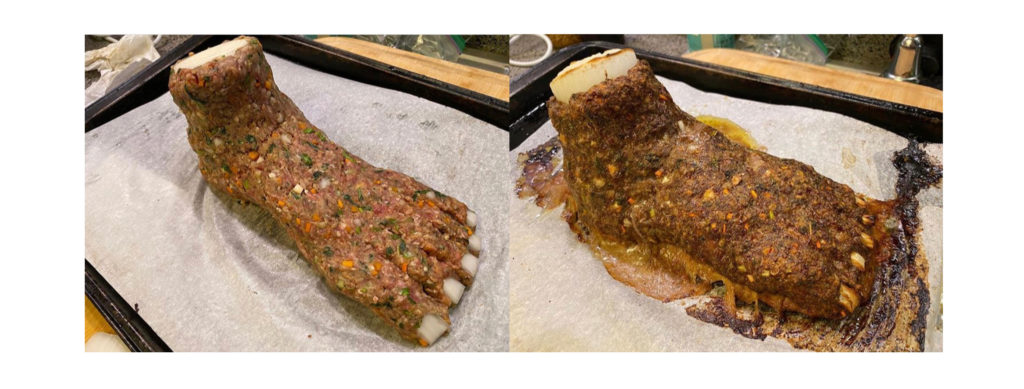
My friend David, a local musician in a band called Tejano Weekend, has channeled some of his creative energy into what I hope is the first of many Tejano Weekend Updates. Watch for some jokes, great music, and drawing tutorials.

Martha, our friend at Waking Giants, has put together a wonderful schedule of online programming for those at home. These include yoga for kids, cooking classes, meditation sessions, and more.
We have a lot of March birthdays in my family (including mine) and I've gotten really good at Zoom happy hours.

Fawn:
First of all, I hope everyone is staying healthy and maintaining some sense of sanity or brief moments of peace through this time of quarantine. As you well know, small businesses have been largely impacted by Covid-19, so I'd like to give a shout out to a couple.
One is Hi-Fi Mycology. Mushrooms are full of nutrition and help keep you in your best health. They are offering pre-orders and farm pickups, as well as being at a handful of farmers markets around town.
Secondly, *shameless plug* if you are in need of something sparkly to spend your stimulus check on, now is a great time to support my glass-blower husband, @stephan_peirce. He has dichroic (sparkly glass) pipes available for sale, and is taking custom work.
I'd also like to give a shout out to JBG's awesome farmer's market crew. Y'all have been doing an amazing job bringing the veggies to the people! Cheers to everyone at the farm, for all their hard work during this unprecedented time. And cheers to our community. SALUD!
Heydon:
Mac Miller's Swimming album has me feeling all the feels during quarantine season. Check out this live performance on Colbert with Jon Batiste for some real feel goodness or his Tiny Desk for some live versions of songs from Swimming. Miss you, Mac.
Faith:
My staff pick this week has been the rainy, drizzly weather. That cool, crisp air is my favorite, and I've really been enjoying opening my window to let the sound of rain in. Very relaxing.Hector:
I came late into the Lego game (pun intended. All my puns are intended) and I'm happy assembling some of the sets I have scored during these days. The most recent one I assembled was the NASA Apollo 11 Lunar Lander. It's a beauty!
This isolation also has piqued my roleplaying itch and I decided to start a Dungeons & Dragons among my friends. I'm the Dungeon Master and 5 other friends will go into adventures from their homes. I used to roleplay a lot while living in Mexico and this will be my first time doing it in English. I hope they like group enjoys what I have planned. If you want to play with your friends, check this website with some of the basics on how to start a group, create a character and get going.
Brenton:
My staff pick has to be the amazing JBG team. I'm so in awe of how hard and how creatively everyone has been working. The usual demands of the spring season plus the added demand for our produce has been hard on everyone at the farm. We just finished up a crazy greenhouse sale, which also was a strain on our crew - we had more demand for transplants this year than ever before. Several of our former employees who lost their jobs found their way back to the farm - filling new and needed positions in the packing shed, delivery shifts, and harvest crews. Seeing some of these employees again, and having them back on the team, is one blessing in disguise from an otherwise difficult time. Tracy, Krishna, Faith, Andrew... all the delivery drivers... the Vicente, Temo, and all the harvest crew... every single person on the farm has been working so hard and I'm so grateful.
Speaking of the transplant sale, a huge thank you to everyone who bought plants this year. We know there are going to be some awesome gardens out there, this year. If you wondering what happened to the leftover plants, they found good homes at The Central Texas Food Bank, New Leaf Agriculture, and Mobile Loaves and Fishes.
We had to buy another delivery truck this week to accommodate the extra deliveries on our plate, and again, I'm just so grateful for a team that can adjust and adapt to our community's needs so quickly and efficiently.
My other pick is my community garden plot. Believe it or not, I've been very busy in the plot at have at the Homewood Heights community garden on the east side. Working here after work and on the weekends has been a good stress reliever for me. I planted so many peppers there! I love this garden - it's so well organized!
I've also been enjoying watching this cultural shift that's happening right now - everyone getting more accustomed and practiced at cooking at home ... something I've been passionate about for a really long time. This week I had a craving for some comfort food, so made a double batch of my grandma's banana pudding... complete with vanilla wafers and all.
Brittany:
I made some pickles that turned out great! Here is a how-to video of me making the pickles.
What you need:
1 English cucumber- sliced
6 sprigs of dill
6 cloves of garlic
3-4 tbsps of white vinegar
1 1/2 tbsps of pink salt
2 tsps of whole peppercorns
1 1/2 cups of water
1-32 oz mason jar or 2- 16 oz
In the mason jar add the english cucumber, sprigs of dill, garlic, and peppercorns. In a separate glass jar add in water, salt and white vinegar. Once salt is dissolved add water mixture to the mason jar. Make sure that the cucumbers are covered. If they are not add some more water and a splash of vinegar.
They will be ready in 5 days! Enjoy!
Inspired by: gimmesomeoven.com
Mike Mo:
Too early to recommend Pandemic on Netflix? Nope, Mike. Seems like the perfect time.
COOKING IN THE TIME OF CORONA
04/03/20 — Ada Broussard
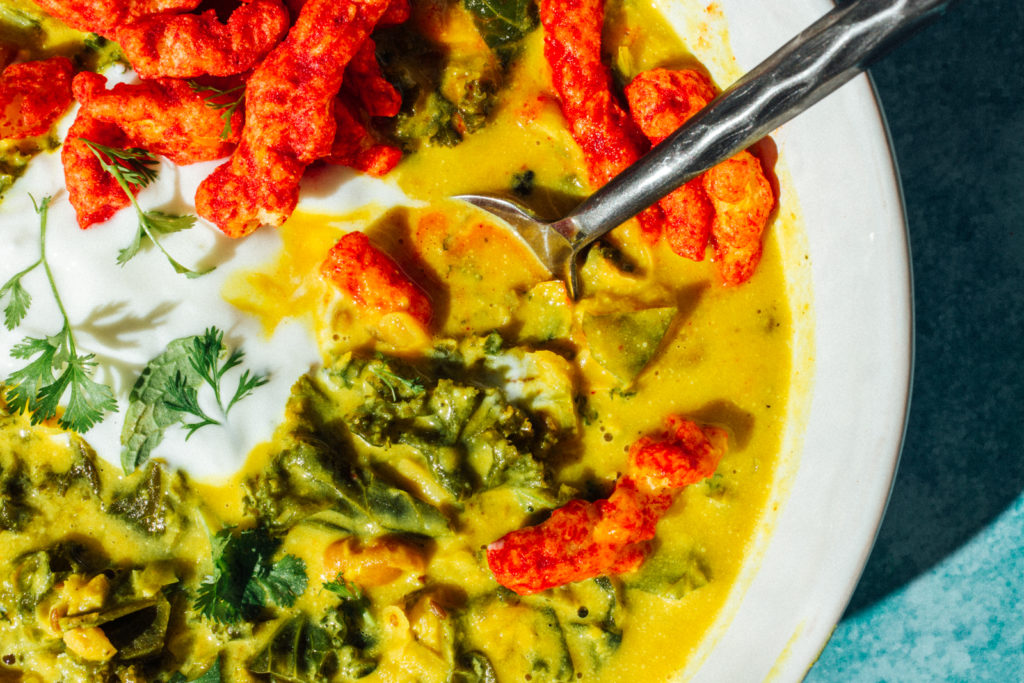 This week Mackenzie put Cheetos on her stew, proving that you can do anything you want when you're cooking at home, in the time of Corona. Photo and Cheetos topping by Mackenzie Smith.
This week Mackenzie put Cheetos on her stew, proving that you can do anything you want when you're cooking at home, in the time of Corona. Photo and Cheetos topping by Mackenzie Smith.
Hello! Ada here. For those of you who don’t know me, howdy! I’ve worked at JBG for 8 or so years and have had the pleasure of having a kitchen stocked of seasonal vegetables for about that long. I still work for the farm, part time, and when I’m not wearing my JBG trucker hat I’m thinking about cooking at home, meal prepping, seasonal eating, and the current contents of my fridge and freezer. I do this with my friends and family, and also through the lens of my meal prep business, Club Home Made. We usually get together, drink wine, and prep food in community. Of course, these meal prep gatherings are on hold for now, but the home cooking skills we preach are coming in handy these days. Shameless plug: follow us on Instagram for cooking tips and lots and lots of baby goat videos, as of late. Today, I’m putting on my Club Home Made hat and talking about cooking in the time of Corona.
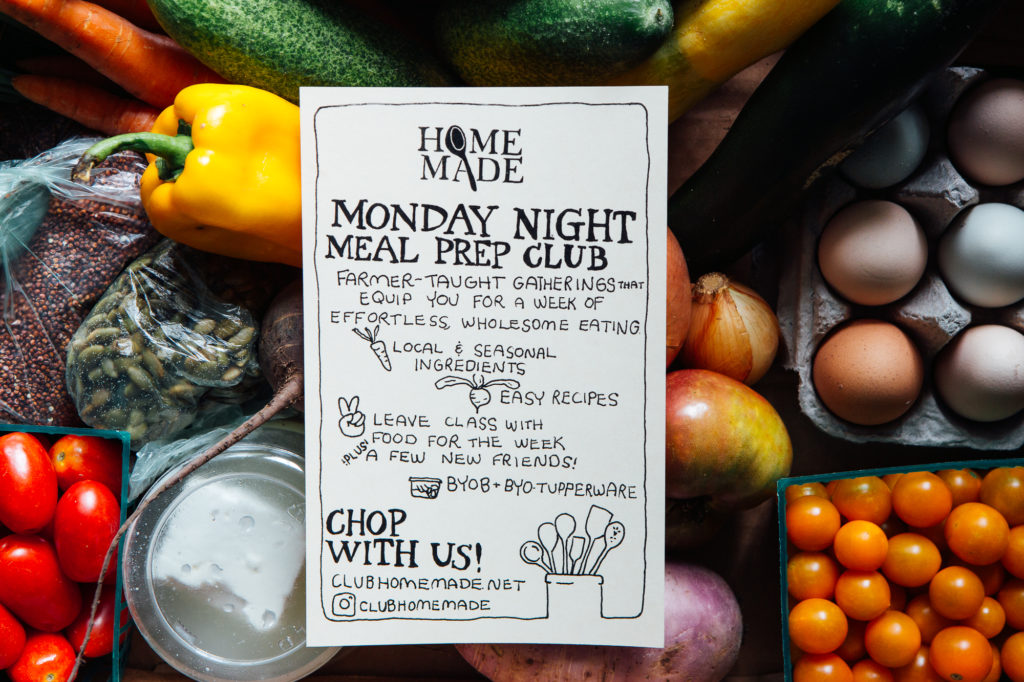
It seems like everyone is cooking at home these days, and while the circumstances surrounding this new food revolution are less than appetizing, the end result is something to marvel. Families are at home with time for slow-cooked soups and also no time for the sudden and urgent need for a quick lunch, with whatever happens to be in the fridge. [Hint, I like to keep tortillas and cheese on hand for an instant quesadilla crowd pleaser. Another go-to snack of mine is some sort of dip made from whatever CSA veggie is lingering in my fridge. Like the beet hummus recipe below.] To all of my friends out there who are also homeschooling their kiddos, I’m sure I don't need to remind you that in addition to being a teacher, you’re also now doing the job of an entire cafeteria staff. How are you doing out there? Remember, there is no shame in eating quesadillas for lunch, everyday. My friend Jessica says she’s cooked more in these last three weeks than she has in the past year. I love to watch Jessica, as well as the entire internet, hone in their knife skills, Instapot settings, and kitchen creativity, and I hope that everyone is having fun (or at least mostly fun) while doing it.
 Here is one of my best friends Jessica - a screenshot I snapped while she was busy cooking in the time of Corona. We were doing a bit of real-time recipe consultation, but the onion glasses were all her idea. Jessica was making venison spaghetti, and apparently there is some for me in the freezer.
Here is one of my best friends Jessica - a screenshot I snapped while she was busy cooking in the time of Corona. We were doing a bit of real-time recipe consultation, but the onion glasses were all her idea. Jessica was making venison spaghetti, and apparently there is some for me in the freezer.
If you’re new to cooking this much, I can honestly say that JBG and Club Home Made are here to support you. Shoot us an Instagram message or email if you have no idea what to do with beets...again, or if you just need some veggie storage tips. The good news is that the fresh vegetables you get from JBG, or any local farm for that matter, should make your job easy. These seasonal fruits and vegetables deserve to be the star of at least some of the meals you prepare. Not only will simple preparations help these vegetables “taste like themselves” as Alice Waters often says, but they will also free up some mental and physical time for you. Shop responsibly at grocery stores and equip yourself with a few basic ingredients that can be combined with a couple of fresh vegetables and herbs, and there are endless ways to deliciously go from hungry to full.
I don’t think I’m alone when I say that this week was a bit of a turning point for me and my household in regards to being isolated - the puzzles seemed a little less fun, the zoom happy hours a little more somber, and my anxiety definitely higher. But you know who isn’t crippled with anxiety or fear right now? All the vegetables that astutely keep doing their thing, responding to the longer sunshine hours and warming soil temperatures. Long walks outside and working in my garden are my happy places right now, and I know everyone is saying it, but it’s beautiful outside. It’s about to be hot as all get-up in Texas, and the cool spring breezes and blankets of wildflowers are as temporal as the JBG’s dark leafy greens and bunched beets. If you’re not outside enjoying nature, I hope you at least enjoy the farm’s vegetables as an extension of the beautiful seasonal shift happening right now. Below are some quick ideas for simple, seasonal dishes that show off our spring harvest and make them taste like themselves.
Chard:
Food writer Tamar Adler taught me a lot about the simplicity of boiling food. (Really, it’s one of the smartest meal-prep moves you can make. I’ve been doing it with potatoes ever this post, but now I boil other things, too.) Bring a salted pot of water to boil, and drop in chard stems that have been chopped to pieces that are about 2 inches long. Once the stems are very tender, take them out. In a separate pan, heat up some olive oil, garlic, and whatever fresh herbs came in your CSA box (chopped). Once the garlic is fragrant, add the drained stems and toss to coat. Salt and freshly cracked black pepper to taste. I trust you can figure out something to do with the silky chard leaves, but it’s the stems that I feel don’t get enough attention.Herbs:
Fresh herbs are a joy to have in the kitchen. They can liven up anything you cook, and turn leftovers into new-overs. The one time I’ve been to the grocery store lately the rice and grains isle was obliterated, except for the lentils. Lucky for me, I love lentils. Boil lentils until tender. (See, more boiling! You don’t have to worry about proportions, just cook like pasta for the easiest treatment.) Drain lentils and mix with chopped herbs of any sort, olive oil, salt, lemon juice, and a couple tablespoons of tahini, if you have it. Want something more substantial? Add crumbles of feta or crispy fried onions on top. Great minds obviously think alike, because after I wrote this bit about herbs, Mackenzie submitted her recipe this week which was another herby-inspired salad. If I want something quick and green to accompany a meal, I finely chop a whole bunch of parsley, stems and all, and mix with olive oil, salt, and lemon juice. Stir in thinly sliced celery or radishes, and maybe add something sweet like cranberries or a bit of honey. Or, blend herbs in soups or dips (see below), or roughly chop and add to a mixed green salad. My favorite herb, by far, is parsley, and let it be known that it will soon be too hot for her tender little leaves. If you haven’t embraced parsley this season, do quickly and with rigor because it will soon be basil-o'clock, which isn’t necessarily a bad thing.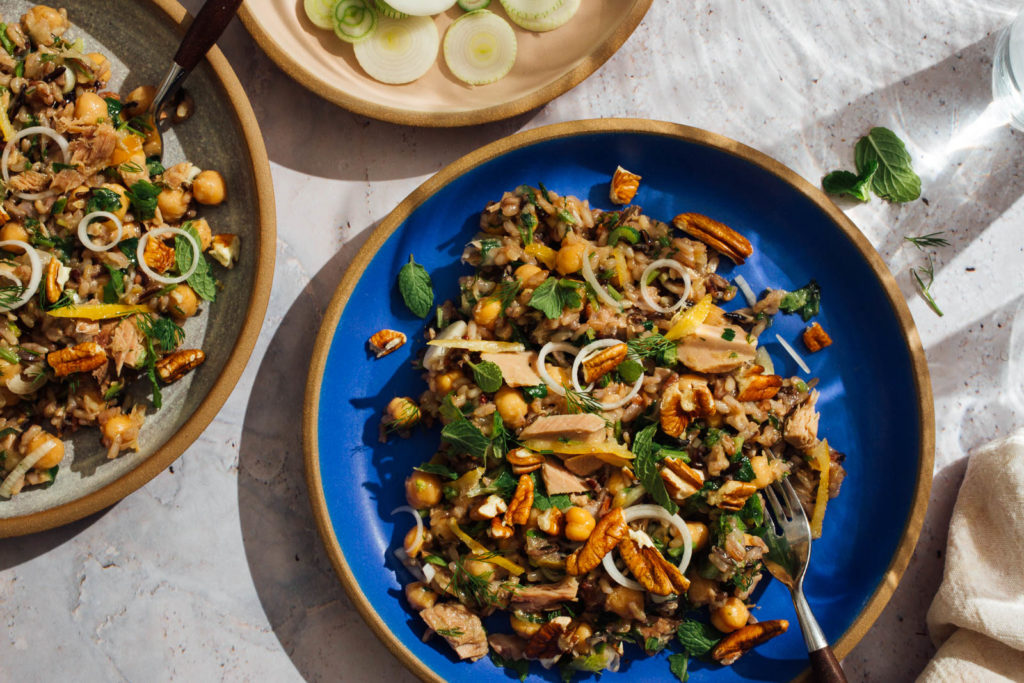 Mackenzie's herby chickpea salad. Recipe is on our homepage, now! Photo by Mackenzie Smith.
Mackenzie's herby chickpea salad. Recipe is on our homepage, now! Photo by Mackenzie Smith.
Spinach:
By far the most popular leafy green. Mild and sweet in flavor, JBG spinach, in my opinion, is best eaten raw. Unlike other bunched greens which are more quickly harvested, tender spinach leaves require a bit more care. Handfuls are harvested by hand, and then eventually need to be individually bagged. Treat them like the jeweled leaves that they are. My favorite spinach salad as of late involves browning some torn mushrooms in lots of olive oil. Once the mushrooms are about done, add some chopped garlic to the pan, cook, then add lemon juice (and maybe some zest?) to the pan. Pour this warm mushroom/oil mixture of the spinach, add cheese and nuts, and enjoy. Ooo! How could I forget? When I feel like putting in the extra mile, I fry up some bacon first, then cook the mushrooms in the leftover grease. Bacon and spinach salads are classic for good reason.If you must cook your spinach, make a simple pureed soup: gently saute an onion and garlic in olive oil, then add the spinach. Cover with delicious broth, or water, and season with salt and pepper. Use an immersion blender or regular blender to blend it up and enjoy the soup as-is on day one, then dolloped with sour cream or yogurt on day two, maybe drizzled with sesame oil, chopped herbs, and croutons on day three, and spooned over rice on day four.
Spring Onions:
If there was ever a harbinger of spring, it would be onions. On a farm on in the wild, you can see wide varieties of onions popping up and gaining momentum. The onions you’re currently receiving will soon size up to be big bulbs which can be stored for the long haul, but these spring beauties are more tender and mild. Add the chopped onion tops to literally anything savory. I can’t think of a dish that green onions wouldn’t enhance. Keeping the bottom of the blub in tact, slice the whole onion in quarters or 8ths lengthwise and cook in some hot oil for the beginning of a stirfry. If you’re ambitious enough to light a fire, rub these with oil and salt, and roast whole. Eat with your hands like a onion-pop, or pull out the steak knife.Carrots:
I’m not sure that JBG does any crop better than we do our carrots. Carrots can be difficult to germinate and are time consuming to harvest, especially when bunched. The very best way to enjoy our carrots, if you’re not crunching on them raw like a bunny, is simply roasted. Unless the carrots are very small, cut them in half lengthwise. Use your (washed) hands and toss with olive oil, salt, and pepper, and roast in a 400 degree oven until tender and beginning to caramelize on the bottom. For the best roasted carrots, rotate your pans in the oven, do not crowd the carrots, and put the cut-side down. In my house, these roasted carrots almost always get eaten right right off the tray, but leftover roasted carrots make wonderful additions to salads, grain bowls, tacos, or curries. Or carrot hummus. The greens make a pretty tasty pesto, as well.*Funny story: I once had another farmer ask me if Brenton walked around the farmers’ markets munching on carrots as a marketing ploy. Of course, the answer is no - they’re just that good!
Collards:
I fell deeply in love with collards several seasons ago while working at JBG. I would eat a bunch, or several, everyday. I used to scoff at the notion of slow-cooking collards and thought a quick saute with a fresh squeeze of lemon was best. (To be clear, this is delicious, too.) But a big pot of collards, slowly cooked till then hit with a dash of vinegar, is so comforting. And don't we all need a bit of comfort, now? Collard's sturdy nature lends them to slow cooking, whether it be by themselves or thrown into a stew or curry.Fennel:
When I used to live in Israel, my friend Tia would shave raw fennel, hit it with some lemon juice and salt, and serve it next to a bowl of yogurt or hummus. This preparation is for the true fennel fanatics. I use fennel in one of two ways: If I’m cooking anything that involves a mirepoix (or holy trinity, as I was taught) I add diced fennel to the mix. This is especially true if the thing I’m cooking happens to be even remotely Italian-ish. Add the fennel just after the onions, and it will melt into whatever dish you’re making and give it a deep, sweet flavor. The other way I love fennel is roasted: cut the bulb into ½ steaks or even quarters and toss with lots of olive oil and salt. Roast in a hot (400ish) degree oven until tender and caramelized. But please don’t turn on your oven just for one fennel bulb - go ahead and roast some carrots or turnips, while you’re at it. Roasted fennel gets added to everything, but especially to a grain salad of sort which I’m oft to make at least once a week. Make tea with the fronds - steep in boiling water and add a bit of sugar, too.Radishes:
Use a mandolin or very careful knife skills to thinly slice your radishes. Toss with olive oil, salt, pepper, lemon, and maybe some herbs, and enjoy a fresh radish salad along with any dinner. Or grate them! Cut radishes, carrots, and even some beets into matchsticks and toss with a yogurty salad dressing for a radish-forward slaw. Put sliced radishes on toast with butter or maybe avocado and some big flaky salt. Radishes are the cucumbers of the winter: their bright and juicy crunch can replace cukes in a cold pasta salad or can be quickly pickled for topping tacos and sandwiches. If you find yourself stumped by radishes, simply slice the ones you get in your CSA box and store them in a closed Tupperware, covered in water. Put the sliced (and ready to go) radishes out on your dinner table with every meal, and you’ll start to see just how useful this crunchy, spicy vegetable truly is.Dandelion Greens:
These bitter and nutritious greens are best eaten when your body is craving a reprieve from the Corona cookies. My favorite way to eat cooked greens is simply sauteed with garlic and served with a big scoop of freshly steamed white rice, cooked in homemade chicken stock or with a heavy helping of quality butter. The bitter greens with the fatty and fluffy rice is often all that I need for a late dinner. If I’m looking to make a more substantial meal out of it, add a fried egg or roasted veggies. Or a simple, parsley salad.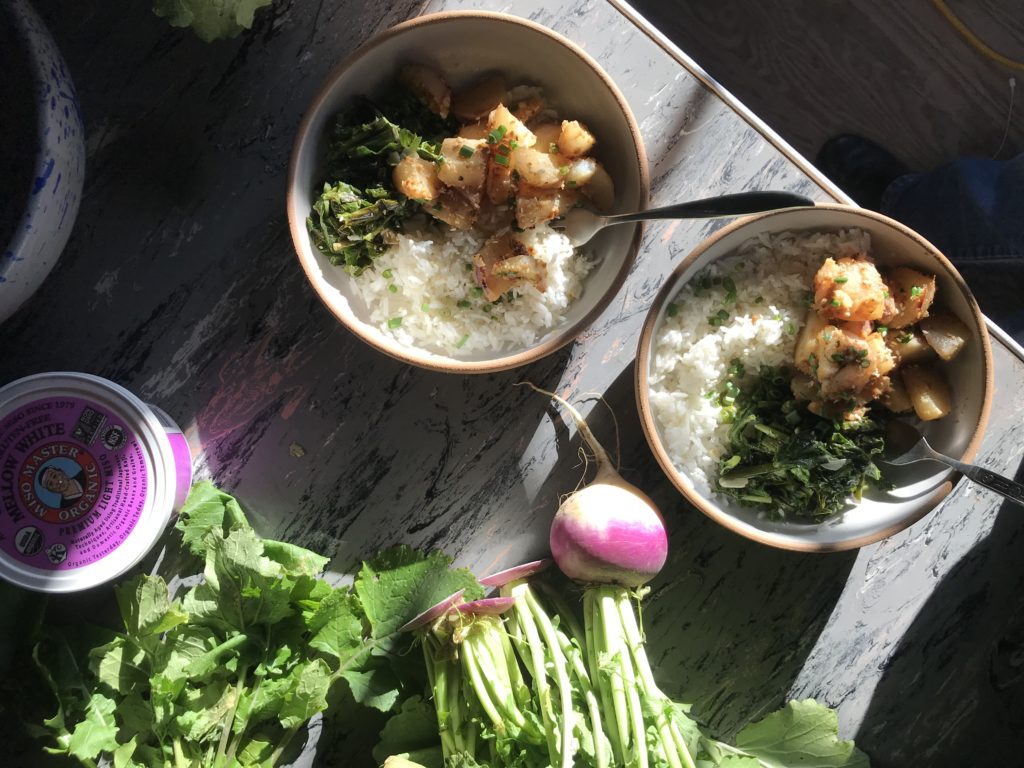 These are technically turnip greens in this picture, but they were cooked just as described in the dandelion greens. Also in this bowl are some miso and butter glazed turnips, recipe below. Photo from Ada's kitchen.
These are technically turnip greens in this picture, but they were cooked just as described in the dandelion greens. Also in this bowl are some miso and butter glazed turnips, recipe below. Photo from Ada's kitchen.
Turnips:
I think turnips are the most underrated vegetable of the fall and spring. These sweet taproots can function like a potato in just any dish you’d like, but really, they’re a bit more forgiving than a potato because they can be delicious raw, al dente, or mixed up with cream, cheese (or cream cheese) for mashed potato sub. My favorite way, as of late, to cook turnips is to braise them with a bit of butter and a bit of miso: In a pan or pot with a lid, toss quartered turnips with a few tablespoons of butter, equal amounts of miso, salt and pepper, and then pour in enough water or broth to barely cover the turnips. Simmer, covered, until the turnips or tender. Once tender, remove the lid and let the water evaporate. Skip the miso and double up on the butter, or simply roast the turnips. Whatever you do, don’t miss out on the sweet and gentle nature of these springtime bulbs. Cook the greens, too.Beets:
Golden, red, or the willy-wonka chioaga, beets are truly a fall and spring crop. If you’ve been a CSA member for a while, you know that we had some major beet crop failure this past fall, and so these spring beets are *hopefully* an exciting addition to your box. If you’ve never blended up your beets to make a delicious dip, perfect for salty chips or a piece of thick crusty bread, go ahead and do that. Recipe below. If I’m roasting just 1 or 2 beets, I try to find a moment when my oven is on anyway, then wrap these up in foil and throw in the back corners until they are soft. My mind was blown when I found out how many restaurants batch-roast beets: Fill up a pyrex or oven safe dish with a bit of water (an inch or so), plop your scrubbed beets in there, then tightly wrap the top with foil. If I’m cooking a bunch (ha!) of beets, I use this method, which yields the most tender, juicy, and delicious beets. The skin sluffs off easily with your fingers, and then you can use said fingers or a bit of freshly roasted beet to blush your cheeks or tint your lips. Who cares that you’re not going anywhere? Treat the greens like the sexy, silky, spinach substitute that they are and cook gently with a bit of garlic and olive oil. Here I am, at one of my Club Home Made gatherings. Mackenzie caught me blushing with beets.
Here I am, at one of my Club Home Made gatherings. Mackenzie caught me blushing with beets.
Beet Hummus:
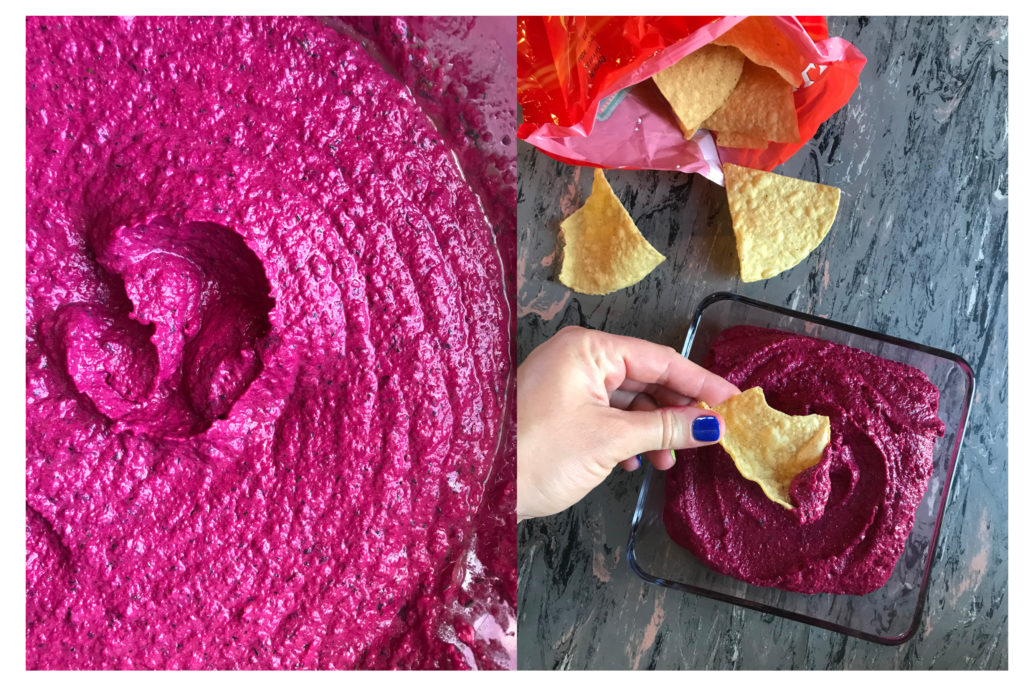
Quarter peeled and roasted beets and put them in a bowl. (They should be very soft. If the skin doesn't come off very easily, they need to go longer.) Add about an equal volume of canned (drained) chickpeas. Canned white beans would work great here, too! I think I used about 6-9 roasted beets.
Add about 3-5 cloves of garlic, more if you have more beets. Add a very generous glug of olive oil. A quarter cup? Add about the same amount of tahini. Maybe a little less.
Add as many chopped "tender" herbs as you feel comfortable with. I used parsley and dill. Honestly, you can go pretty heavy on the herbs. They will help brighten the earthy flavor of the beets.
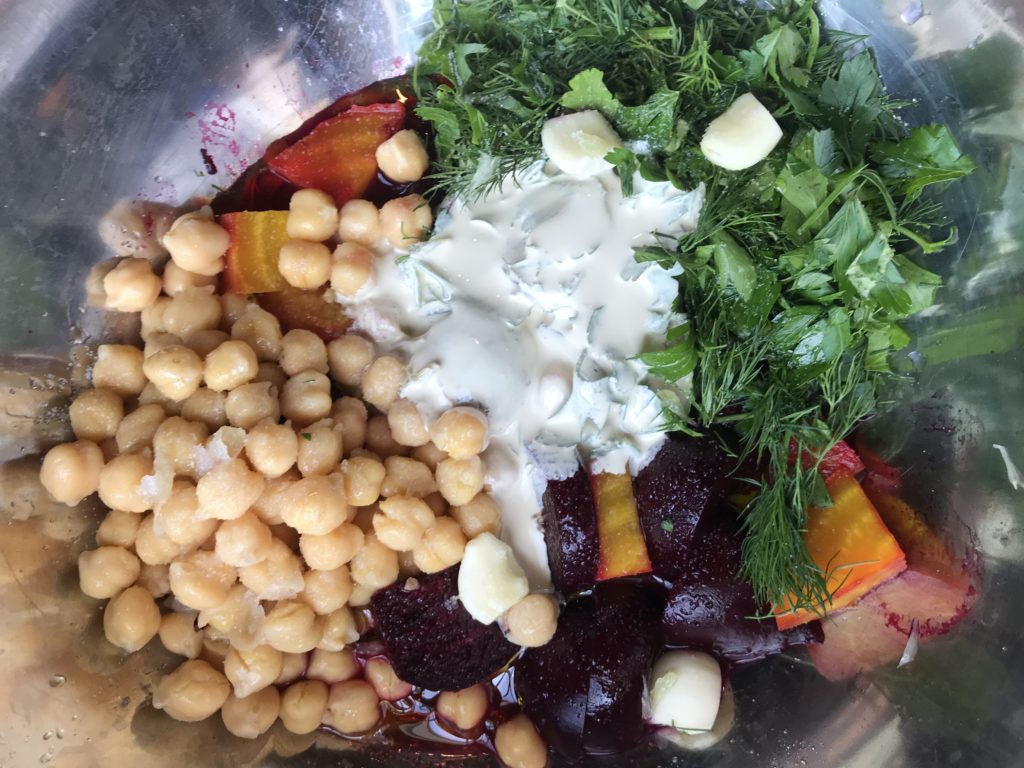
Add a lot of acid: lemon or lime juice if you have it, and maybe some red wine vinegar if you don't. I used lime juice because it's what I had. (Zest, too, if you're feeling fancy!)
Salt!
Blend it up! I used an immersion blender. Taste, and add more salt if it's bland, acid if it's too early, and olive oil if it's too chunky. I needed to add more of all three after my first blend. Serve with tortilla chips, pita chips, or maybe even slathered on a wrap.
I've also made versions of this dip using plain yogurt instead of tahini. It's a creamier dip, and is very delicious! Sub roasted carrots for the beets in either the tahini or yogurt version! Also, if I had a hot pepper (jalapeno or serrano) I would have added some of that to the beet hummus - the spice will help balance the earthiness.
CSA BOX CONTENTS WEEK OF APR 6TH
04/06/20 — Scott
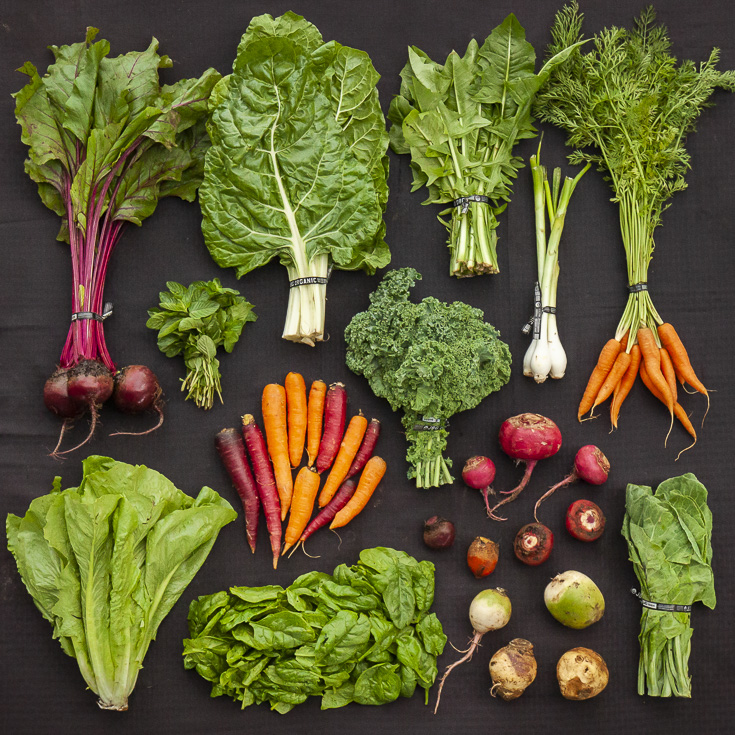 CSA Box Contents Week of Apr 6th
CSA Box Contents Week of Apr 6th
Large Box
Beets
Bok Choy
Carrots
Greens, Chard, Rainbow
Greens, Dandelion
Greens, Kale, Curly
Greens, Spinach
Herb, Farmers Choice
Leek
Lettuce, Romaine
Radish, Watermelon
Beets
Bok Choy
Carrots
Greens, Chard, Rainbow
Greens, Dandelion
Greens, Kale, Curly
Greens, Spinach
Herb, Farmers Choice
Leek
Lettuce, Romaine
Radish, Watermelon
Medium Box
Beets
Bok Choy
Carrot, Orange
Greens, Chard, Rainbow
Greens, Kale, Curly
Herb, Farmers Choice
Leek
Lettuce, Romaine
Radish, Watermelon
Beets
Bok Choy
Carrot, Orange
Greens, Chard, Rainbow
Greens, Kale, Curly
Herb, Farmers Choice
Leek
Lettuce, Romaine
Radish, Watermelon
Small Box
Beets
Carrots
Greens, Chard, Rainbow
Greens, Dandelion
Greens, Kale, Curly
Herb, Farmers Choice
Lettuce, Romaine
Beets
Carrots
Greens, Chard, Rainbow
Greens, Dandelion
Greens, Kale, Curly
Herb, Farmers Choice
Lettuce, Romaine
Individual Box
Beets
Carrot, Orange
Greens, Chard, Rainbow
Greens, Kale, Curly
Herb, Farmers Choice
Lettuce, Romaine
Beets
Carrot, Orange
Greens, Chard, Rainbow
Greens, Kale, Curly
Herb, Farmers Choice
Lettuce, Romaine
CSA BOX CONTENTS WEEK OF APR 6TH
04/07/20 — Scott
 CSA Box Contents Week of Apr 6th
CSA Box Contents Week of Apr 6th
Large Box
Beets
Carrots
Greens, Chard, Rainbow
Greens, Collards
Greens, Dandelion
Greens, Kale, Curly
Greens, Spinach
Herb, Farmers Choice
Lettuce, Romaine
Roasting Veggies
MISO GLAZED TURNIPS
04/09/20 — Ada Broussard
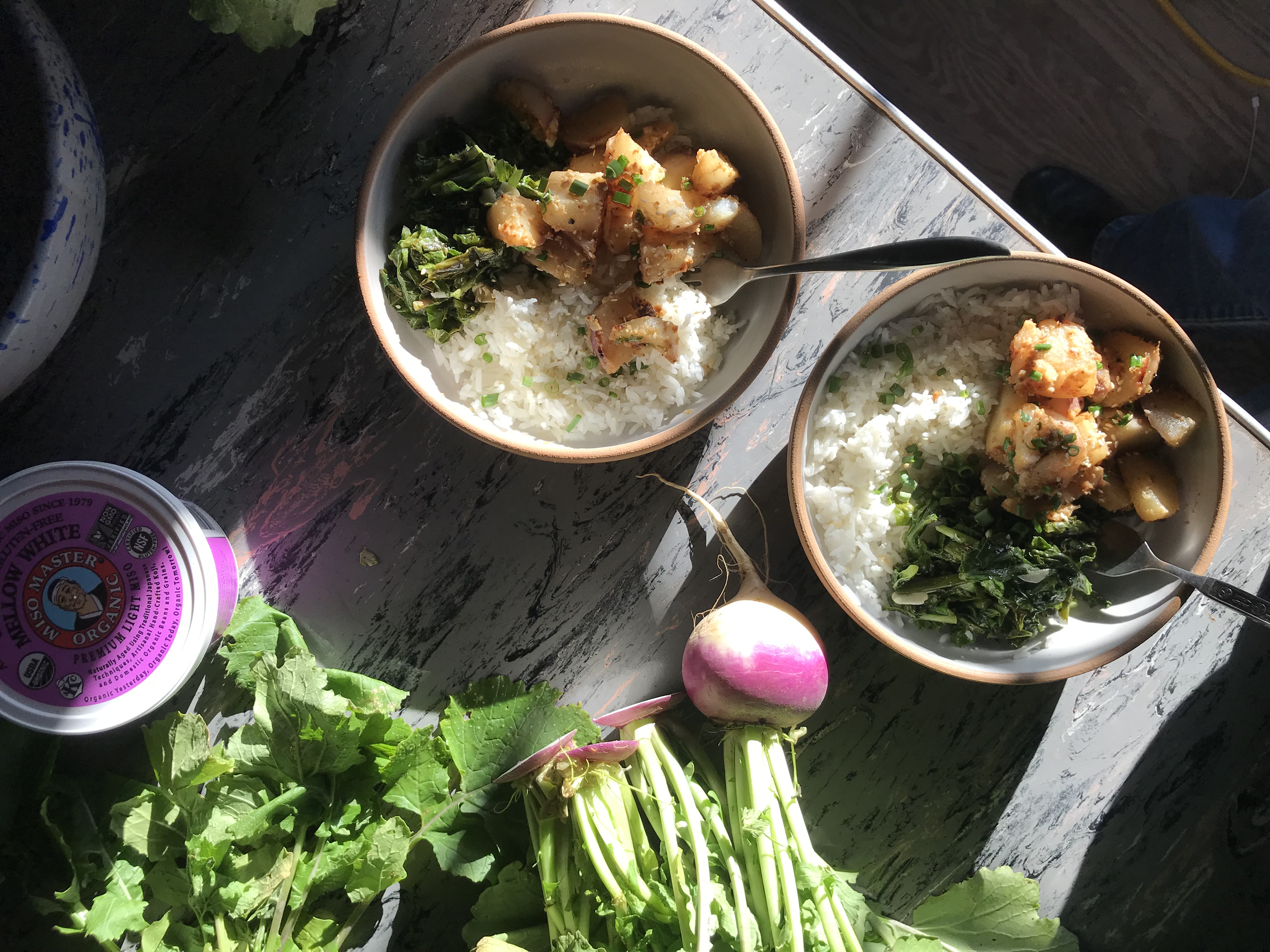
Recipe and Photo by Ada Broussard
I’ve seen recipes for “miso glazed turnips” for quite some time and finally decided to give it a go. After all, I’ve got nothing but time, and a fridge full of turnips. I made a very large skillet of these turnips. Most were enjoyed over some steamed rice, alongside sauteed turnip greens, and the rest were eaten straight from the pan that sat on the stove for the next couple of hours. These were truly a hit, and I’ll be using cooking turnips this way again and again. I love turnips for many reasons, one being that beneath that juicy sweet meat is a bit of delightful bitterness. If you're new to the turnip train and are wary of bitter flavors, consider sprinkling these turnips with a bit of sugar (when you add the salt) or honey (at the end).
- Turnips - Use however many you have. This recipe is based on having about 4 large of 5 medium turnips. This recipe would work well for scarlet, purple top, or white turnips.
- 2-3 tablespoons of white or yellow miso
- 2 tablespoons butter
- About 1 cup water or broth
- Salt
- Pepper
- Chopped herbs like thyme, parsley, dill, or chopped green onions.
PHOTOS FROM THE FARM: 4.10.20
04/10/20 — Ada Broussard
Spring is in full swing at the farm and Scott captured some magical morning shots of the busy-calm that seems to have settled over the whole farm.
![]() We're not packing more CSA boxes than ever. This week's box colorful box contents are hopefully a source of joy for all of our CSA Members - veterans and newbies, alike. Photo by Scott David Gordon.
We're not packing more CSA boxes than ever. This week's box colorful box contents are hopefully a source of joy for all of our CSA Members - veterans and newbies, alike. Photo by Scott David Gordon.
![]() CSA Shares wrapped and ready to go. We have had to hire new delivery drivers and even purchase a new delivery vehicle to meet this incredible demand. Photo by Scott David Gordon.
CSA Shares wrapped and ready to go. We have had to hire new delivery drivers and even purchase a new delivery vehicle to meet this incredible demand. Photo by Scott David Gordon.
![]() Might as well be a watercolor painting. Photo by Scott David Gordon.
Might as well be a watercolor painting. Photo by Scott David Gordon.
![]() A cool misty morning like this is welcome weather. Before we know it, it will be 90 degrees by 9am. Photo by Scott David Gordon.
A cool misty morning like this is welcome weather. Before we know it, it will be 90 degrees by 9am. Photo by Scott David Gordon.
![]() On your mark, get set.... Photo by Scott David Gordon.
On your mark, get set.... Photo by Scott David Gordon.
![]() Here, Vicente pulls our under-cutter bar and gets the beds of carrots ready to bunch. This implement works pretty well to prep for carrot-harvesting, but reaches it's optical performance with the help of some added weight. Photo by Scott David Gordon.
Here, Vicente pulls our under-cutter bar and gets the beds of carrots ready to bunch. This implement works pretty well to prep for carrot-harvesting, but reaches it's optical performance with the help of some added weight. Photo by Scott David Gordon.
![]() Romaine calm, they say. Photo by Scott David Gordon.
Romaine calm, they say. Photo by Scott David Gordon.
![]() String will be strung between these wooden stakes - helping to support our tomato plants, which will grow into an unruly jungle in just a couple of months. Photo by Scott David Gordon.
String will be strung between these wooden stakes - helping to support our tomato plants, which will grow into an unruly jungle in just a couple of months. Photo by Scott David Gordon.
![]() Order seeds, plant seeds, nurture transplants, prep beds, plant tomatoes, place stakes, string tomatoes.... if you've ever wondered why organic tomatoes from your local farm are a bit more expensive than their conventional grocery store counterparts, these stakes are part of the reason why. A successful tomato crop takes is truly a labor of love. Photo by Scott David Gordon.
Order seeds, plant seeds, nurture transplants, prep beds, plant tomatoes, place stakes, string tomatoes.... if you've ever wondered why organic tomatoes from your local farm are a bit more expensive than their conventional grocery store counterparts, these stakes are part of the reason why. A successful tomato crop takes is truly a labor of love. Photo by Scott David Gordon.
![]() An army of tomatoes, waiting to be stakes. Photo by Scott David Gordon.
An army of tomatoes, waiting to be stakes. Photo by Scott David Gordon.
![]() Thousands and thousands of pounds of tomatoes to come. Soon, you'll be able to reserve your box of 'maters, making all of your home canning dreams come true. Photo by Scott David Gordon.
Thousands and thousands of pounds of tomatoes to come. Soon, you'll be able to reserve your box of 'maters, making all of your home canning dreams come true. Photo by Scott David Gordon.
![]() Even the tractors are socially distancing. Photo by Scott David Gordon.
Even the tractors are socially distancing. Photo by Scott David Gordon.
![]() It has been, and continues to be planting season. Here, another succession of younger tomatoes is going in next to their older tomato amigos. Photo by Scott David Gordon.
It has been, and continues to be planting season. Here, another succession of younger tomatoes is going in next to their older tomato amigos. Photo by Scott David Gordon.
![]() Spinach harvest. Popeye would be proud. Photo by Scott David Gordon.
Spinach harvest. Popeye would be proud. Photo by Scott David Gordon.
![]() Carlos is spreading organic fertilizer before we shape the beds. Photo by Scott David Gordon.
Carlos is spreading organic fertilizer before we shape the beds. Photo by Scott David Gordon.
![]() This year we've planted around 15,000 tomato plants. Needless to say, that requires a lot of stakes. Photo by Scott David Gordon.
This year we've planted around 15,000 tomato plants. Needless to say, that requires a lot of stakes. Photo by Scott David Gordon.
![]() Here, we're cultivating in between the carrot crops to minimize the weed pressure. Photo by Scott David Gordon.
Here, we're cultivating in between the carrot crops to minimize the weed pressure. Photo by Scott David Gordon.
![]() We heard you guys liked carrots... Photo by Scott David Gordon.
We heard you guys liked carrots... Photo by Scott David Gordon.
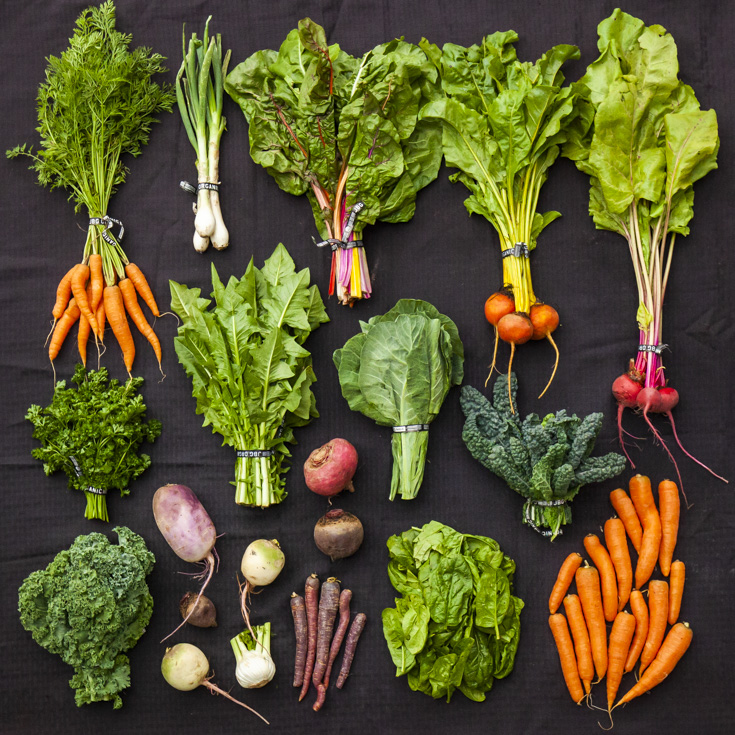 We're not packing more CSA boxes than ever. This week's box colorful box contents are hopefully a source of joy for all of our CSA Members - veterans and newbies, alike. Photo by Scott David Gordon.
We're not packing more CSA boxes than ever. This week's box colorful box contents are hopefully a source of joy for all of our CSA Members - veterans and newbies, alike. Photo by Scott David Gordon.
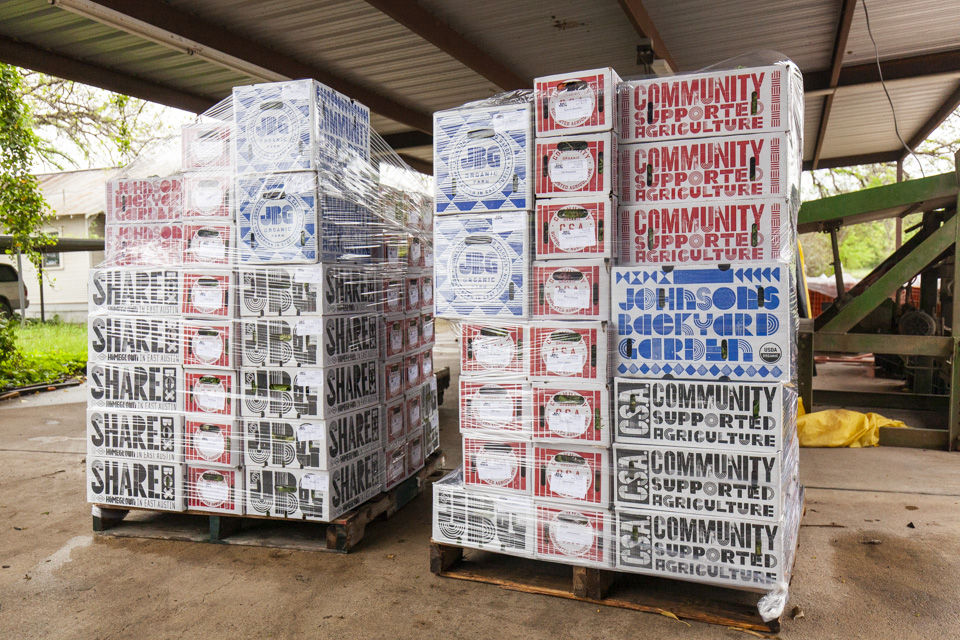 CSA Shares wrapped and ready to go. We have had to hire new delivery drivers and even purchase a new delivery vehicle to meet this incredible demand. Photo by Scott David Gordon.
CSA Shares wrapped and ready to go. We have had to hire new delivery drivers and even purchase a new delivery vehicle to meet this incredible demand. Photo by Scott David Gordon.
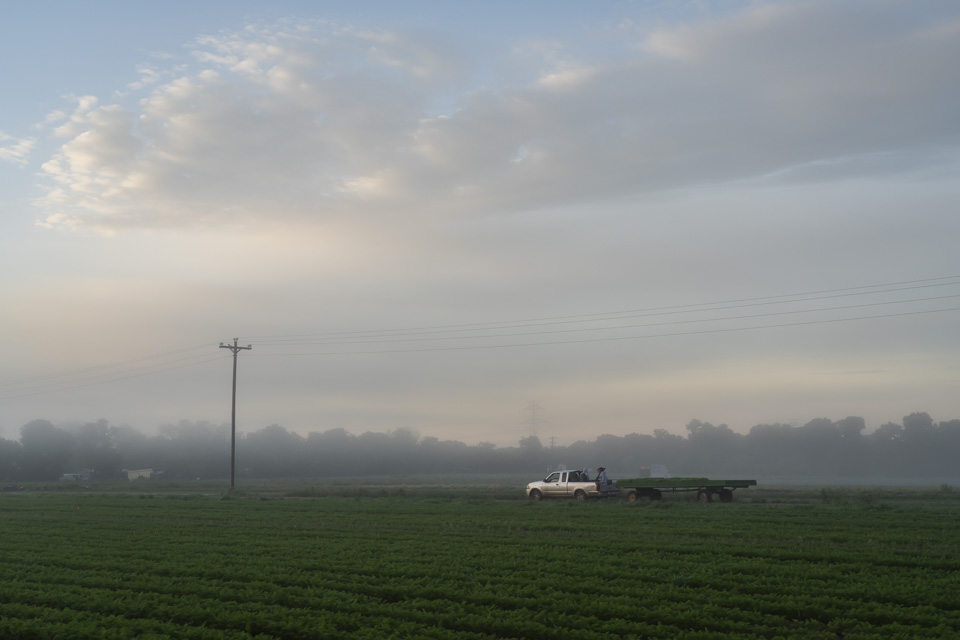 Might as well be a watercolor painting. Photo by Scott David Gordon.
Might as well be a watercolor painting. Photo by Scott David Gordon.
 A cool misty morning like this is welcome weather. Before we know it, it will be 90 degrees by 9am. Photo by Scott David Gordon.
A cool misty morning like this is welcome weather. Before we know it, it will be 90 degrees by 9am. Photo by Scott David Gordon.
 On your mark, get set.... Photo by Scott David Gordon.
On your mark, get set.... Photo by Scott David Gordon.
 Here, Vicente pulls our under-cutter bar and gets the beds of carrots ready to bunch. This implement works pretty well to prep for carrot-harvesting, but reaches it's optical performance with the help of some added weight. Photo by Scott David Gordon.
Here, Vicente pulls our under-cutter bar and gets the beds of carrots ready to bunch. This implement works pretty well to prep for carrot-harvesting, but reaches it's optical performance with the help of some added weight. Photo by Scott David Gordon.
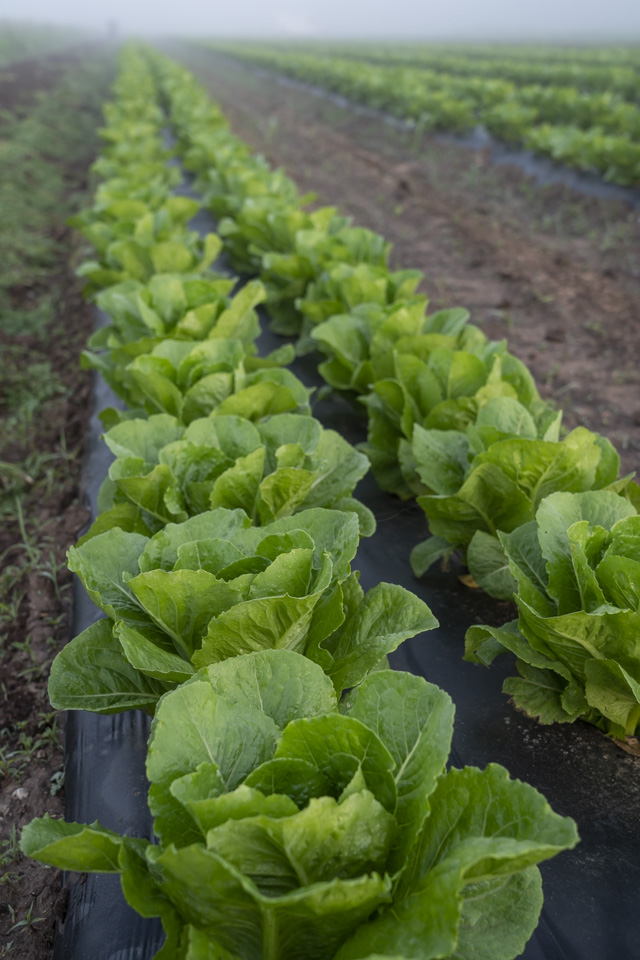 Romaine calm, they say. Photo by Scott David Gordon.
Romaine calm, they say. Photo by Scott David Gordon.
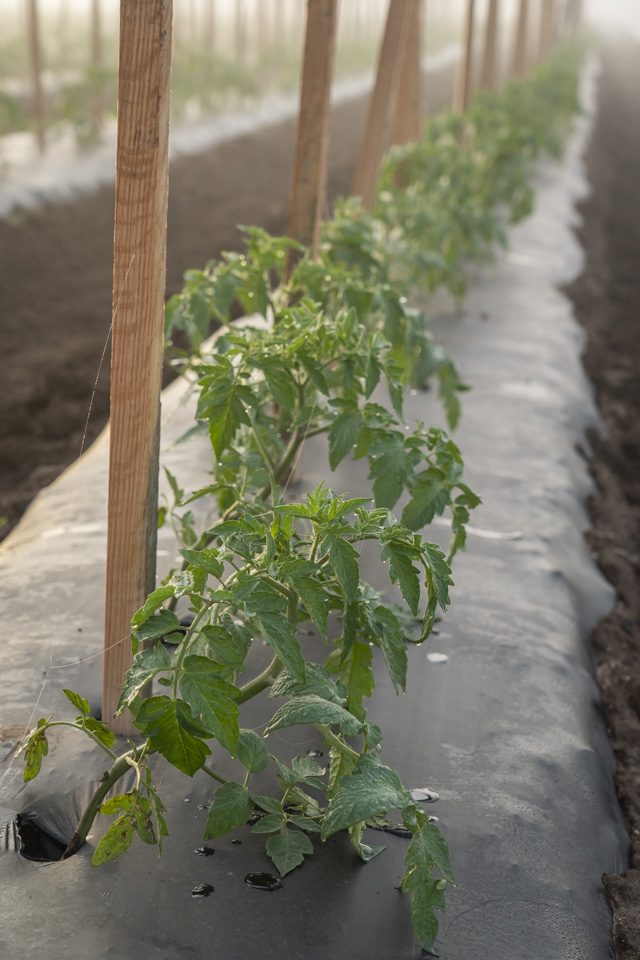 String will be strung between these wooden stakes - helping to support our tomato plants, which will grow into an unruly jungle in just a couple of months. Photo by Scott David Gordon.
String will be strung between these wooden stakes - helping to support our tomato plants, which will grow into an unruly jungle in just a couple of months. Photo by Scott David Gordon.
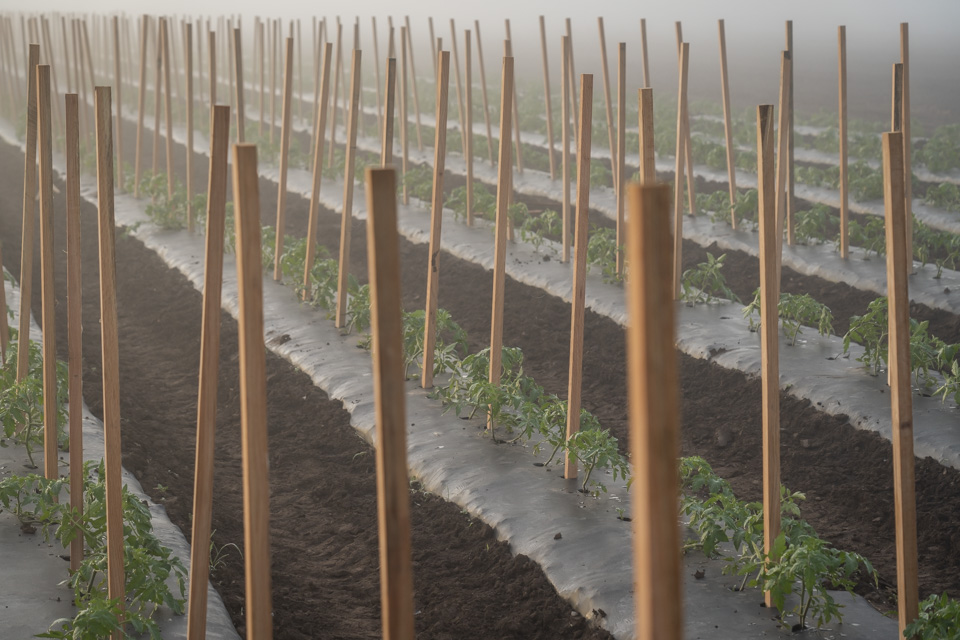 Order seeds, plant seeds, nurture transplants, prep beds, plant tomatoes, place stakes, string tomatoes.... if you've ever wondered why organic tomatoes from your local farm are a bit more expensive than their conventional grocery store counterparts, these stakes are part of the reason why. A successful tomato crop takes is truly a labor of love. Photo by Scott David Gordon.
Order seeds, plant seeds, nurture transplants, prep beds, plant tomatoes, place stakes, string tomatoes.... if you've ever wondered why organic tomatoes from your local farm are a bit more expensive than their conventional grocery store counterparts, these stakes are part of the reason why. A successful tomato crop takes is truly a labor of love. Photo by Scott David Gordon.
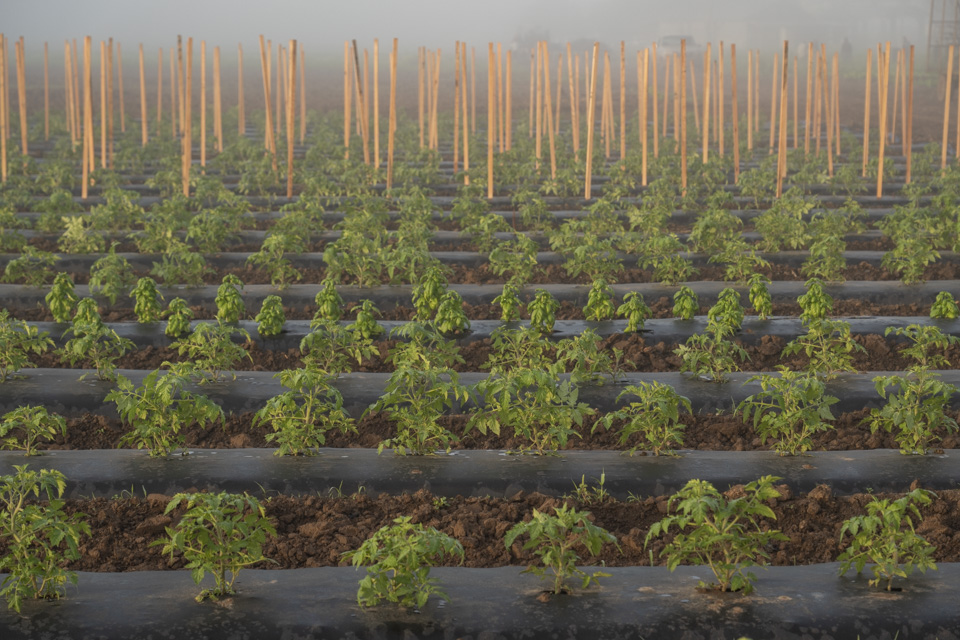 An army of tomatoes, waiting to be stakes. Photo by Scott David Gordon.
An army of tomatoes, waiting to be stakes. Photo by Scott David Gordon.
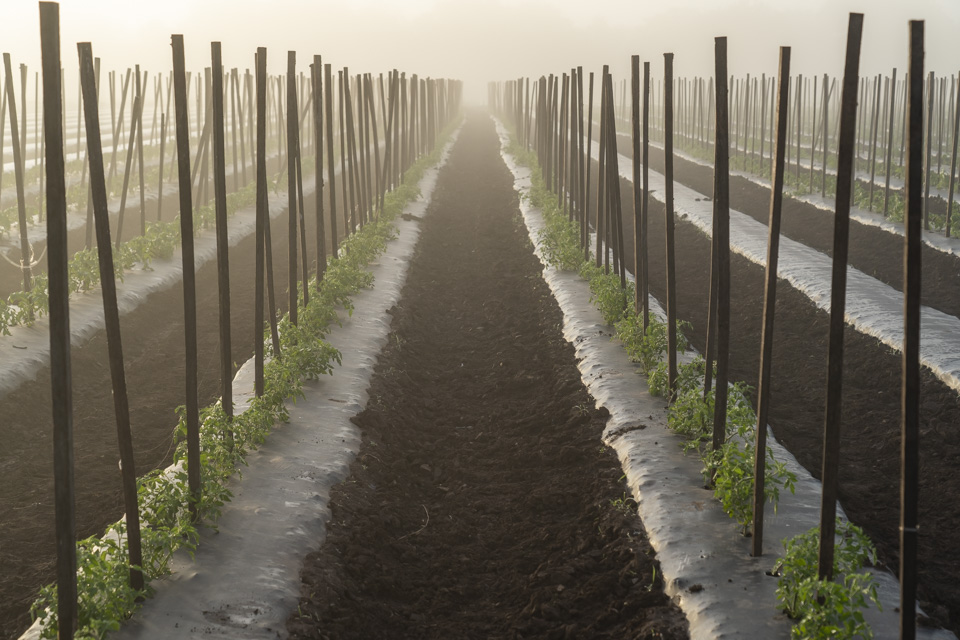 Thousands and thousands of pounds of tomatoes to come. Soon, you'll be able to reserve your box of 'maters, making all of your home canning dreams come true. Photo by Scott David Gordon.
Thousands and thousands of pounds of tomatoes to come. Soon, you'll be able to reserve your box of 'maters, making all of your home canning dreams come true. Photo by Scott David Gordon.
 Even the tractors are socially distancing. Photo by Scott David Gordon.
Even the tractors are socially distancing. Photo by Scott David Gordon.
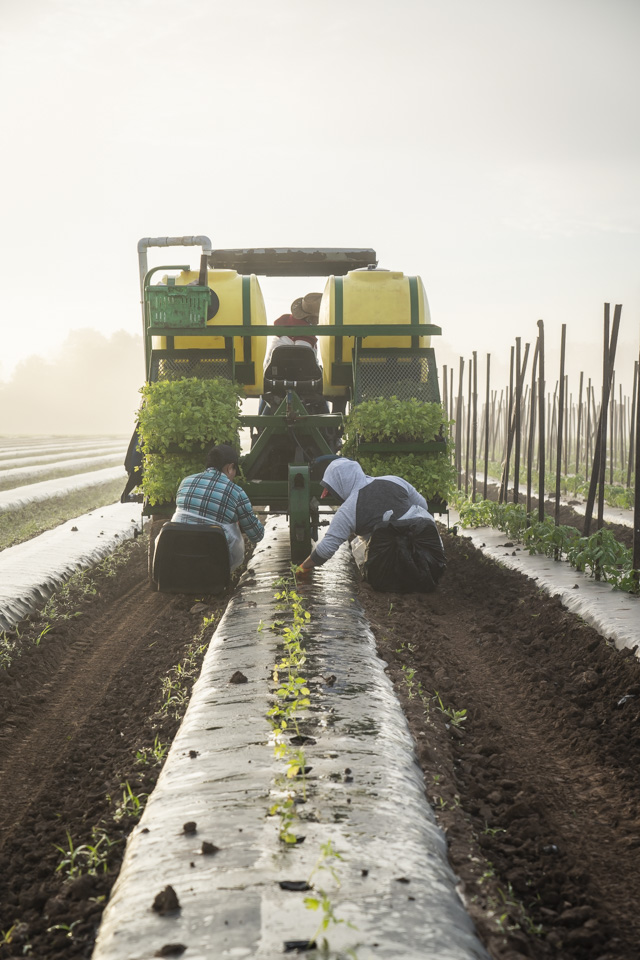 It has been, and continues to be planting season. Here, another succession of younger tomatoes is going in next to their older tomato amigos. Photo by Scott David Gordon.
It has been, and continues to be planting season. Here, another succession of younger tomatoes is going in next to their older tomato amigos. Photo by Scott David Gordon.
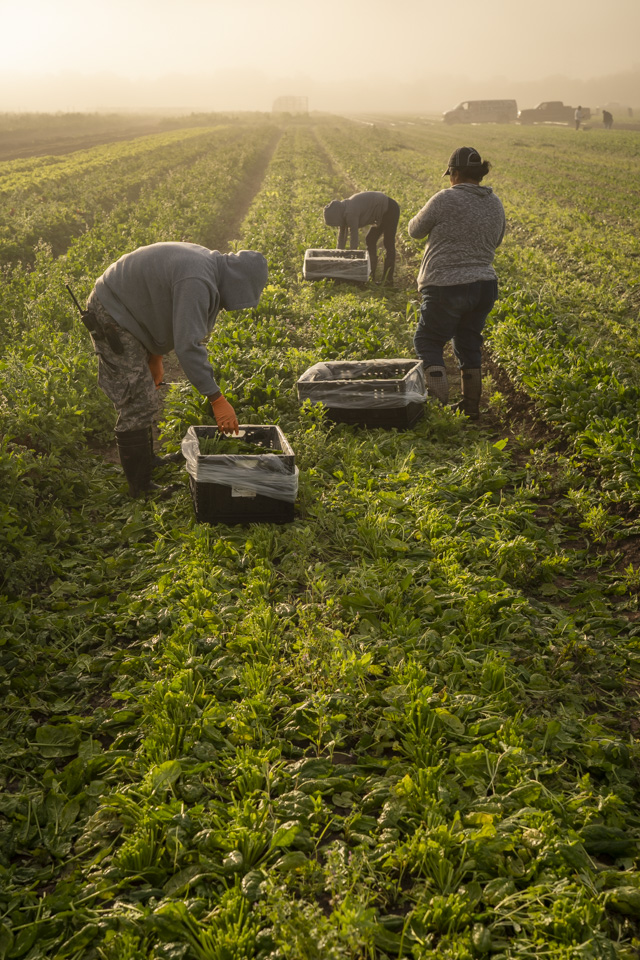 Spinach harvest. Popeye would be proud. Photo by Scott David Gordon.
Spinach harvest. Popeye would be proud. Photo by Scott David Gordon.
 Carlos is spreading organic fertilizer before we shape the beds. Photo by Scott David Gordon.
Carlos is spreading organic fertilizer before we shape the beds. Photo by Scott David Gordon.
 This year we've planted around 15,000 tomato plants. Needless to say, that requires a lot of stakes. Photo by Scott David Gordon.
This year we've planted around 15,000 tomato plants. Needless to say, that requires a lot of stakes. Photo by Scott David Gordon.
 Here, we're cultivating in between the carrot crops to minimize the weed pressure. Photo by Scott David Gordon.
Here, we're cultivating in between the carrot crops to minimize the weed pressure. Photo by Scott David Gordon.
 We heard you guys liked carrots... Photo by Scott David Gordon.
We heard you guys liked carrots... Photo by Scott David Gordon.JBG ONIONS: ALL(IUM) YOU NEED TO KNOW
04/10/20 — Ada Broussard
This week we are revisiting a very timely post, all about onions. Original post written by Heydon Hatcher.
Here at the farm, spring means ONIONS! That’s right, we thought this week we would dive into a little history, relay some fun facts, delve into how we cultivate this labor-intensive crop, and generally praise this lovely allium.
This veggie has been part of the human diet for over 7000 years! There have been traces of onions found by archaeologists dating back to 5000 BC. Being easily transportable, storing well and for long periods of time, and growing in a vast array of climates and soil, this bulb has been ubiquitous throughout history. Tracing back to Chinese gardens thousands of years ago, referenced in Indian Vedic writings, mentioned in the Bible, the pilgrims even brought onions on the Mayflower only to discover that Native Americans already grew a different varietal. Talk about a veggie that has really helped the human race thrive - this one has really run the gamut. Egyptians worshipped onions - they saw eternity in the concentric rings that make up its anatomy. They would place onions in Pharaohs' tombs to ensure a full and prosperous afterlife. Greek athletes would consume massive amounts of this veggie prior to significant athletic contests as they believed it would make them significantly stronger! Throughout the years, onions have been thought to aid vision, eliminate dysentery, strengthen joints, alleviate sores of all sorts, and even heal snake bites. What CAN’T this vegetable do?! We cannot get enough of onions, and hope that this post will make your heart grow fonder of them, too.
![]() Montana and the onion. Photo by Scott David Gordon.
Montana and the onion. Photo by Scott David Gordon.
Onions hail from the Allium family... its members are often distinguished for having high sulfur compounds which contribute to their unique aroma and taste (sulfenic acid is what makes you cry when you cut into a fresh onion!). Leeks, garlic, scallions, shallots, and chives are some of the other veggie members of this perennial, flowering, and bulb-producing veggie fam. Despite the first paragraph’s talk of the onion’s omniscience throughout history, don’t be fooled, this crop is one of our more complicated vegetables to cultivate, and also one of our most important. Onions are one of our head farmer's favorites. He loves to tell the long and storied past of his travails with figuring out the cultivation of this bulb as it was so elusive to him for years, back when his farm fit in his backyard. He stumbled upon an onion mentor in the midst of his allium endeavors: Bruce “Onionman” Frasier, the head farmer of Dixondale Farms - one of the biggest producers of onions in the United States. Bruce really aided Brenton in his slow-learning onion education, and taught him one very important thing - the perfect onion has 13 rings.
“The size of an onion bulb is dependent upon the number and size of green leaves at the time of bulb maturity. For each leaf, there will be a ring of onion; the larger the leaf, the larger the ring will be. The perfect onion has 13 rings, which means that you should strive for 13 leaves if you want the biggest onions you've ever grown. The 9th leaf is usually the largest leaf on the plant, and that's when the nitrogen fertility should peak. When the 13th leaf appears, the onion is getting ready to start curing. This occurs at about the same time that the rest of the larger leaves have transferred most of their carbohydrates to the rings, so the onion's neck will start getting soft. It won't need as much moisture, which means you should stop irrigating the crop from this point on.” -Bruce Frasier, onion farmer extraordinaire.
Here at JBG, onions are started from seed in the bare ground. At the end of summer/fall, we prepare about 15 beds (want to learn more about the bed-making process? Click here!), plant onion seeds very tightly together, and let them grow for about 6 to 8 weeks. When they get to pencil-length thickness, we pull them out of the ground, yank the tops off (leaving a few inches of green), and move them to another plastic-covered bed. This is to allow them space to spread out, grow, and bulb. This transplanting process usually begins in October or November and takes about 5 or 6 weeks to complete as there are so many beds of onions, plus a massive amount of plant going into those beds! Onions are frost-resistant and massively resilient, so during the winter, they just hang onto the field until the days lengthen and spring sun returns. They really don’t start to grow until around early March, and when this time rolls around, the growth rate really starts to quicken.
![]() Bare ground growing of onions! Photo by Scott David Gordon.
Bare ground growing of onions! Photo by Scott David Gordon.
![]() Transplanting onions. Photo by Scott David Gordon.
Transplanting onions. Photo by Scott David Gordon.
Fun fact: There three different kinds of onions - short-day (bulbing at 10-12 hours of sunlight), day-neutral (bulbing at 12-14 hours of sunlight), and long-day onions (bulbing at 14-16 hours of sunlight). Here in Austin, short-day onions thrive (we are on the verge of day-neutral, though!); thus, we focus on those. What triggers an onion to bulb is the number of hours of daylight it receives. They will only bulb if they get at least the amounts mentioned above. We plant short-day onions in the fall, while we plant the one day-neutral onion varietal we cultivate during the spring. The day length is why we plant at two different times, to make sure the length of light during a day will trigger bulbing. It’s really quite critical to plant onions at the right time of year to get the right amount of growth.
We don’t usually harvest the full bulb onions until around May. However, you might be wondering how to explain those green onions or spring onions you might be seeing at market? These are just tiny baby bulbs of the full-grown bulbs to come in later months. This allium is edible at every point of growth; thus, we harvest all throughout its lifecycle. It’s easy to differentiate green and spring onions because you can spot that spring onions have little baby bulbs, whereas green onions are long, skinny, and slender. We also grow multiplying onions, in late summer and fall to provide green onions during those times. These onions don’t ever form a bulb; however, when they become fully grown, they divide themselves. When you plant one, you’ll get a full chunk of them. These are also super resilient and hardy.
![]() Green onions. Photo by Scott David Gordon.
Green onions. Photo by Scott David Gordon.
![]() Spring onions! Photo by Brenton.
Spring onions! Photo by Brenton.
When we harvest, we cut off the tops with a specialized tool, called onion shears, then cut the roots off of each bulb. We bag them up in 30 lb mesh bags and cure them in the greenhouse in high heat for a week. This removes the excess moisture and lengthens their longevity. Once they are good and papery on the outside, we lay them all out at the barn. We sic a leaf blower on them to remove dry excess skin and then pack them in bulk bins. We get them into cold storage, and they can last 4 to 5 months! Talk about storage crop!
![]() Curing in the greenhouse. Photo by Scott David Gordon.
Curing in the greenhouse. Photo by Scott David Gordon.
This year we are looking forward to a fruitful and long-lasting onion season! We have yellow, red, and white varieties that we are ecstatic to unveil to you in your CSA box and at market. We hope you enjoyed this read and have a fun(ion) weekend. Happy Passover and Easter to those of you celebrating! ‘Til next time.
Here at the farm, spring means ONIONS! That’s right, we thought this week we would dive into a little history, relay some fun facts, delve into how we cultivate this labor-intensive crop, and generally praise this lovely allium.
This veggie has been part of the human diet for over 7000 years! There have been traces of onions found by archaeologists dating back to 5000 BC. Being easily transportable, storing well and for long periods of time, and growing in a vast array of climates and soil, this bulb has been ubiquitous throughout history. Tracing back to Chinese gardens thousands of years ago, referenced in Indian Vedic writings, mentioned in the Bible, the pilgrims even brought onions on the Mayflower only to discover that Native Americans already grew a different varietal. Talk about a veggie that has really helped the human race thrive - this one has really run the gamut. Egyptians worshipped onions - they saw eternity in the concentric rings that make up its anatomy. They would place onions in Pharaohs' tombs to ensure a full and prosperous afterlife. Greek athletes would consume massive amounts of this veggie prior to significant athletic contests as they believed it would make them significantly stronger! Throughout the years, onions have been thought to aid vision, eliminate dysentery, strengthen joints, alleviate sores of all sorts, and even heal snake bites. What CAN’T this vegetable do?! We cannot get enough of onions, and hope that this post will make your heart grow fonder of them, too.
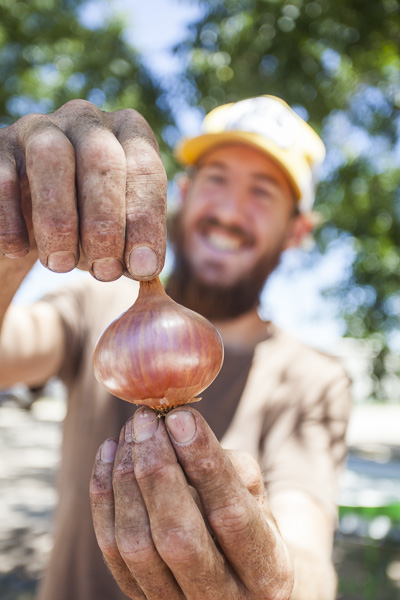 Montana and the onion. Photo by Scott David Gordon.
Montana and the onion. Photo by Scott David Gordon.
Onions hail from the Allium family... its members are often distinguished for having high sulfur compounds which contribute to their unique aroma and taste (sulfenic acid is what makes you cry when you cut into a fresh onion!). Leeks, garlic, scallions, shallots, and chives are some of the other veggie members of this perennial, flowering, and bulb-producing veggie fam. Despite the first paragraph’s talk of the onion’s omniscience throughout history, don’t be fooled, this crop is one of our more complicated vegetables to cultivate, and also one of our most important. Onions are one of our head farmer's favorites. He loves to tell the long and storied past of his travails with figuring out the cultivation of this bulb as it was so elusive to him for years, back when his farm fit in his backyard. He stumbled upon an onion mentor in the midst of his allium endeavors: Bruce “Onionman” Frasier, the head farmer of Dixondale Farms - one of the biggest producers of onions in the United States. Bruce really aided Brenton in his slow-learning onion education, and taught him one very important thing - the perfect onion has 13 rings.
“The size of an onion bulb is dependent upon the number and size of green leaves at the time of bulb maturity. For each leaf, there will be a ring of onion; the larger the leaf, the larger the ring will be. The perfect onion has 13 rings, which means that you should strive for 13 leaves if you want the biggest onions you've ever grown. The 9th leaf is usually the largest leaf on the plant, and that's when the nitrogen fertility should peak. When the 13th leaf appears, the onion is getting ready to start curing. This occurs at about the same time that the rest of the larger leaves have transferred most of their carbohydrates to the rings, so the onion's neck will start getting soft. It won't need as much moisture, which means you should stop irrigating the crop from this point on.” -Bruce Frasier, onion farmer extraordinaire.
Here at JBG, onions are started from seed in the bare ground. At the end of summer/fall, we prepare about 15 beds (want to learn more about the bed-making process? Click here!), plant onion seeds very tightly together, and let them grow for about 6 to 8 weeks. When they get to pencil-length thickness, we pull them out of the ground, yank the tops off (leaving a few inches of green), and move them to another plastic-covered bed. This is to allow them space to spread out, grow, and bulb. This transplanting process usually begins in October or November and takes about 5 or 6 weeks to complete as there are so many beds of onions, plus a massive amount of plant going into those beds! Onions are frost-resistant and massively resilient, so during the winter, they just hang onto the field until the days lengthen and spring sun returns. They really don’t start to grow until around early March, and when this time rolls around, the growth rate really starts to quicken.
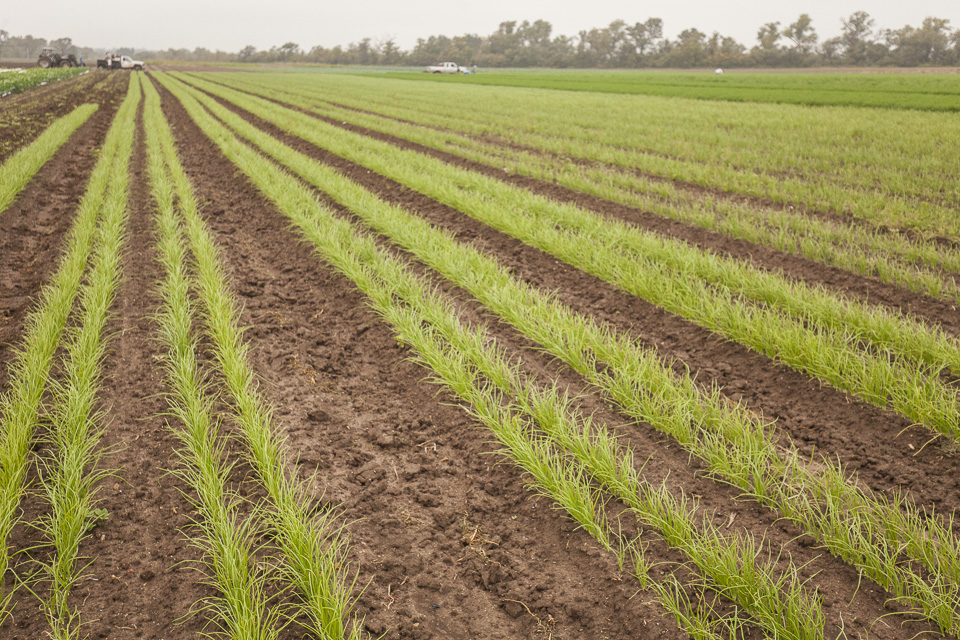 Bare ground growing of onions! Photo by Scott David Gordon.
Bare ground growing of onions! Photo by Scott David Gordon.
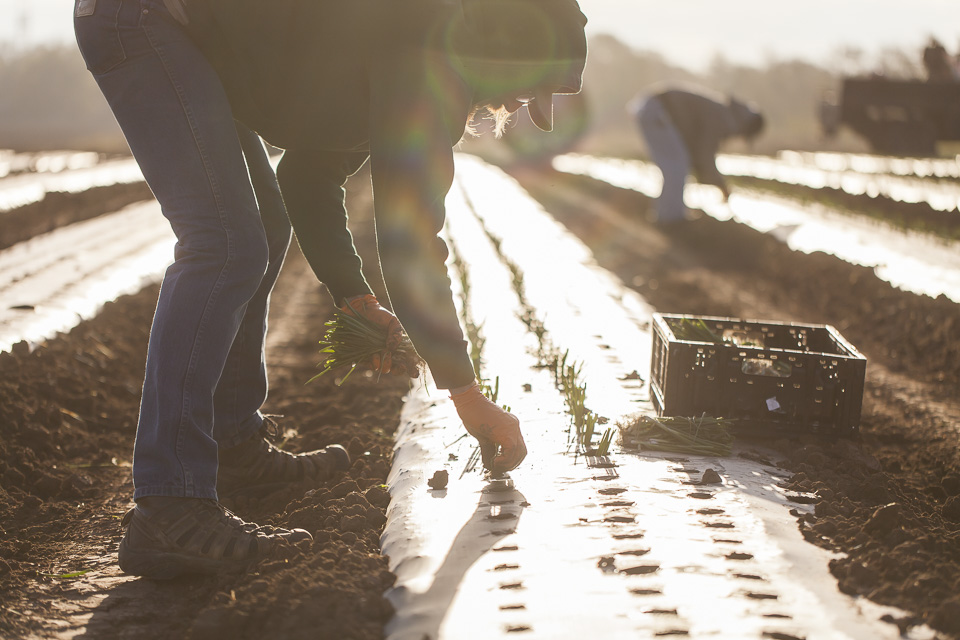 Transplanting onions. Photo by Scott David Gordon.
Transplanting onions. Photo by Scott David Gordon.
Fun fact: There three different kinds of onions - short-day (bulbing at 10-12 hours of sunlight), day-neutral (bulbing at 12-14 hours of sunlight), and long-day onions (bulbing at 14-16 hours of sunlight). Here in Austin, short-day onions thrive (we are on the verge of day-neutral, though!); thus, we focus on those. What triggers an onion to bulb is the number of hours of daylight it receives. They will only bulb if they get at least the amounts mentioned above. We plant short-day onions in the fall, while we plant the one day-neutral onion varietal we cultivate during the spring. The day length is why we plant at two different times, to make sure the length of light during a day will trigger bulbing. It’s really quite critical to plant onions at the right time of year to get the right amount of growth.
We don’t usually harvest the full bulb onions until around May. However, you might be wondering how to explain those green onions or spring onions you might be seeing at market? These are just tiny baby bulbs of the full-grown bulbs to come in later months. This allium is edible at every point of growth; thus, we harvest all throughout its lifecycle. It’s easy to differentiate green and spring onions because you can spot that spring onions have little baby bulbs, whereas green onions are long, skinny, and slender. We also grow multiplying onions, in late summer and fall to provide green onions during those times. These onions don’t ever form a bulb; however, when they become fully grown, they divide themselves. When you plant one, you’ll get a full chunk of them. These are also super resilient and hardy.
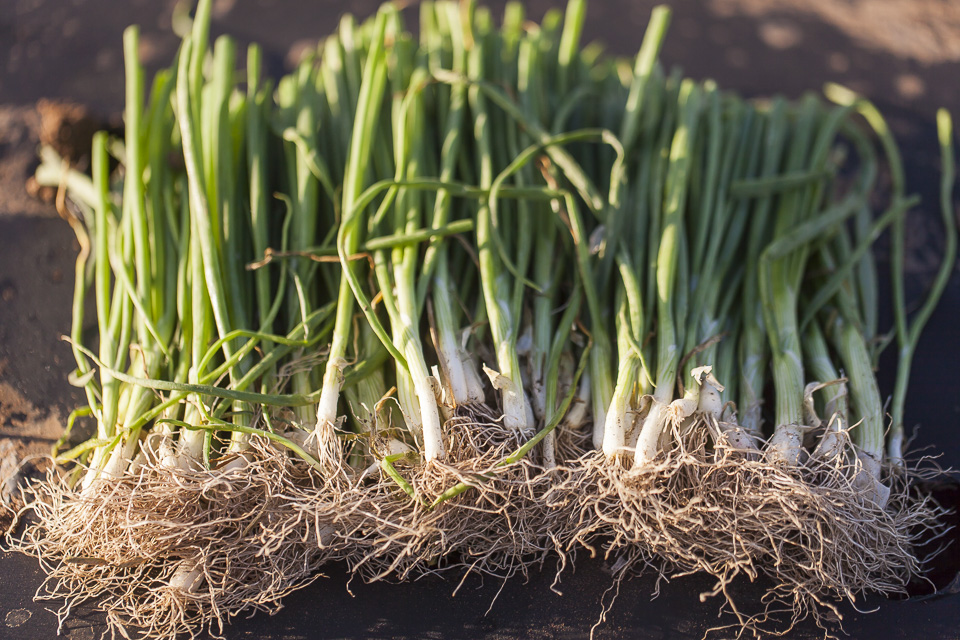 Green onions. Photo by Scott David Gordon.
Green onions. Photo by Scott David Gordon.
 Spring onions! Photo by Brenton.
Spring onions! Photo by Brenton.
When we harvest, we cut off the tops with a specialized tool, called onion shears, then cut the roots off of each bulb. We bag them up in 30 lb mesh bags and cure them in the greenhouse in high heat for a week. This removes the excess moisture and lengthens their longevity. Once they are good and papery on the outside, we lay them all out at the barn. We sic a leaf blower on them to remove dry excess skin and then pack them in bulk bins. We get them into cold storage, and they can last 4 to 5 months! Talk about storage crop!
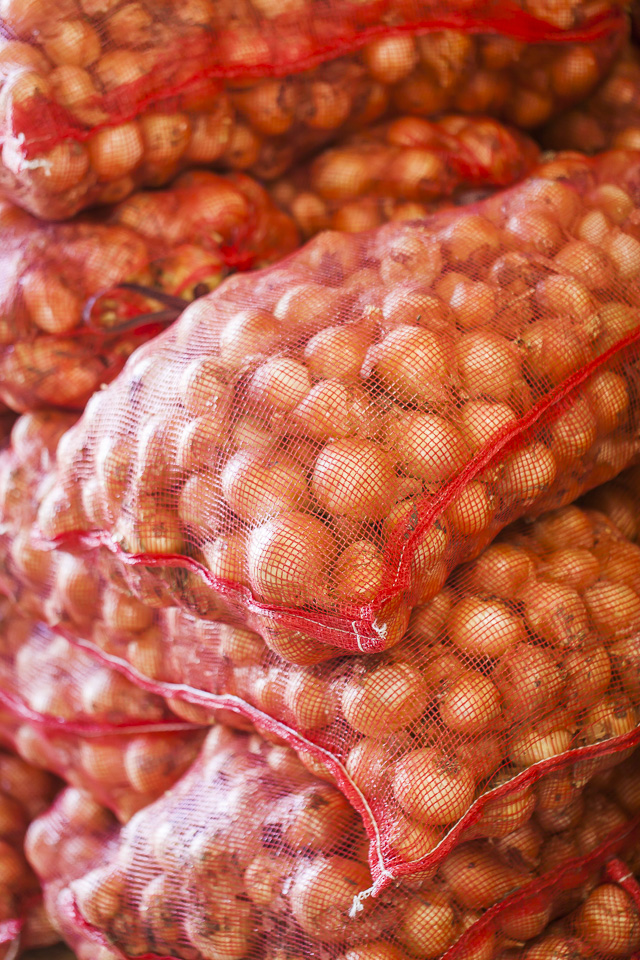 Curing in the greenhouse. Photo by Scott David Gordon.
Curing in the greenhouse. Photo by Scott David Gordon.
This year we are looking forward to a fruitful and long-lasting onion season! We have yellow, red, and white varieties that we are ecstatic to unveil to you in your CSA box and at market. We hope you enjoyed this read and have a fun(ion) weekend. Happy Passover and Easter to those of you celebrating! ‘Til next time.
CSA BOX CONTENTS WEEK OF APR 13TH
04/13/20 — Scott
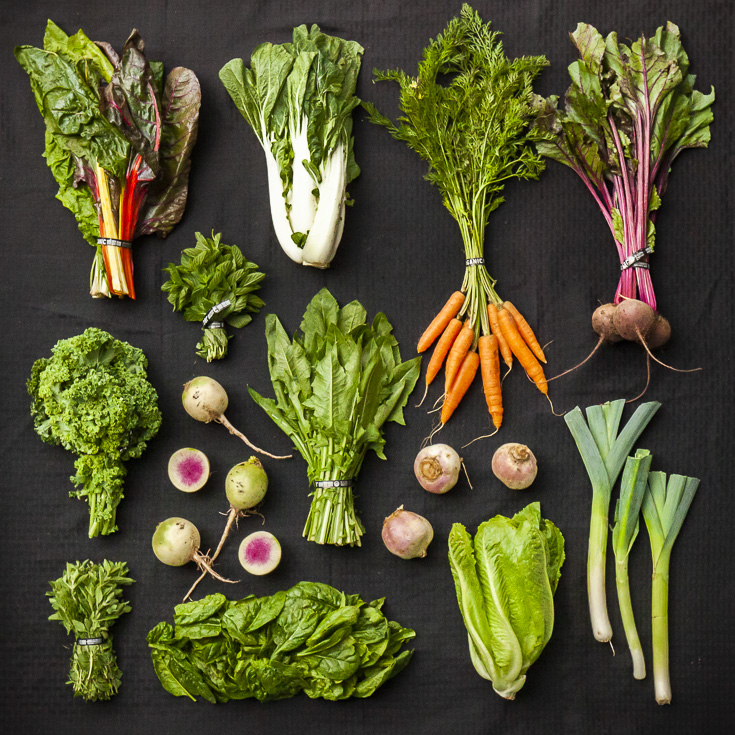
Large Box
Beets
Bok Choy
Carrots
Greens, Collards
Greens, Kale, Curly
Greens, Spinach
Herb, Cilantro
Herb, Fennel
Kohlrabi, Purple
Lettuce, Endive
Lettuce, Romaine
Onion, Spring Yellow
Beets
Bok Choy
Carrots
Greens, Collards
Greens, Kale, Curly
Greens, Spinach
Herb, Cilantro
Herb, Fennel
Kohlrabi, Purple
Lettuce, Endive
Lettuce, Romaine
Onion, Spring Yellow
Medium Box
Beets
Bok Choy
Carrots
Greens, Chard, Rainbow
Herb, Cilantro
Herb, Fennel
Kohlrabi, Purple
Lettuce, Endive
Lettuce, Romaine
Onion, Spring Yellow
Radish, Red
Beets
Bok Choy
Carrots
Greens, Chard, Rainbow
Herb, Cilantro
Herb, Fennel
Kohlrabi, Purple
Lettuce, Endive
Lettuce, Romaine
Onion, Spring Yellow
Radish, Red
Small Box
Beets
Carrots
Greens, Collards
Greens, Kale, Curly
Greens, Spinach
Lettuce, Romaine
Radish, Red
Beets
Carrots
Greens, Collards
Greens, Kale, Curly
Greens, Spinach
Lettuce, Romaine
Radish, Red
Individual Box
Beets
Carrots
Greens, Spinach
Herb, Fennel
Lettuce, Romaine
Beets
Carrots
Greens, Spinach
Herb, Fennel
Lettuce, Romaine
CSA BOX CONTENTS WEEK OF APR 13TH
04/14/20 — Scott
CHIOGGIA ON TOP
04/15/20 — Ada Broussard
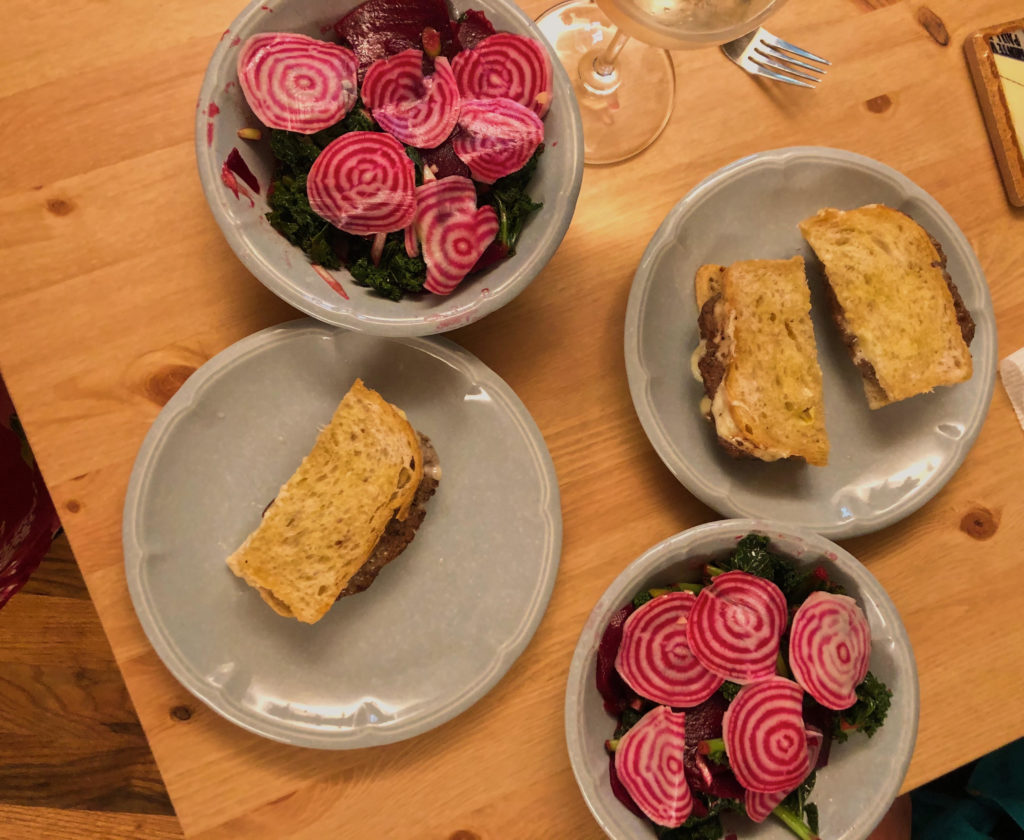 Recipe by Isaac and Heydon
Recipe by Isaac and Heydon
Hi friends! We are hunkered down in quarantine and cooking more than ever. Thankfully, we have a wizard in the kitchen at this humble abode, so I can (very gratefully) busy myself with eating said wizard’s creations and then write about his fruitful culinary escapades sated on the couch, a welcome distraction. This easy salad utilized a ton of the CSA veggies and also brought some much needed colorful nutrition to our diet that has been consisting of mostly beige: think pasta bakes, meaty tacos, you know the drill… savory and so, so delicious, but lacking in vibrant veggies. This was and felt like a salubrious elixir. I even drank some of the remaining beet juice that had pooled at the bottom of the bowl when I finished noshing. Yum.
Ingredients
- 2 chioggia beets
- 3 red beets
- ⅔ bunch of curly kale
- 1 large green onion
- 1 lemon
- Olive oil
- Salt
- Pepper
- Claussen pickle juice or some sort of quick pickle brine
Peel chioggia beets, and cut into paper thin slices. Put them into a cup full of Claussen pickle juice to soak and *quick pickle* while preparing the rest of the salad.
Get a pot of salted boiling water going. Cut the tops off the red beets (and save for a later saute). Once the water is boiling, throw the topless red beets in, and turn the water to low heat. Put a lid on the pot and let simmer for an hour. Check tenderness with a fork. If they are ready, they should be very easily pierced. Put the finished beets in an ice bath. After they are cooled, peel, cut in half, and slice thinly. Put them in a bowl with a third of a cup of olive oil and about 10 grinds of salt. Stir thoroughly. Set in the fridge to marinate.
Trim the stalks off of the kale, and chop coarsely to prepare for the blanching process. Put greens in the pot that you boiled the beets in, as the water should still be hot enough to blanch. Let soak for about a minute, and put into an ice bath. Shake the excess water off the kale and put into a bowl.
Chop a green onion thinly and combine with kale. Add the red beets and the olive oil soak into the mixture as well. Cut a lemon in half and squeeze juice into the bowl and stir. Additionally, grind about 10 grinds of salt, another drizzle of olive oil, and toss.
Serve the salad and garnish top with the stunning quick pickled chioggia beets. Enjoy. Sending love from our home to yours.
CSA MEMBER SPOTLIGHT
04/17/20 — Ada Broussard

Farming, on some days, can feel isolating: working out in a rural landscape, with fields so vast you have to use a radio to talk to your co-worker. It’s you, the plants, and the thousands of variables that affect those plants. Sometimes, this is nice. But sometimes, when the cold wind is stinging your nose, when the hole in your boots first presents itself in the form of wet socks, or when the afternoon sun is beating down and there are still 30 cases of beets to go… sometimes, farming is just plain exhausting. So why do we do it?
Well, we do it for you! Since the backyard days, the community that surrounds our farm and your demand for fresh, healthy produce, is the number one motivator in our agricultural endeavors. CSA stands for Community Supported Agriculture, and this special relationship is one we do not take for granted - it truly supports us: it pays our employees’ wages and finances big purchases like spring seeds, tractor parts, and mountains of compost. When we suddenly needed to buy a new delivery vehicle earlier this month to meet the increased demand for our boxes, it was the upfront payment for new CSA subscriptions that enabled the purchase of our new veggie-mobile. The men and women that make up our CSA community are as diverse as the vegetables we grow, and each and every member helps to form a web that supports our every move.
This week we’re shining a spotlight on just one of our beautiful CSA families - the Browns! Thank you to the Browns, as well as our entire web of CSA Members. We appreciate your partnership and cherish your patronage. We love planting, growing, picking, and delivering vegetables just for you. Hope you enjoy the veggies.
Without further ado, The Browns! Tucked away in the hills just northwest of central Austin live the Browns, a wonderfully down-to-earth family who have successfully incorporated the CSA program into their laid-back and homey kitchen since December of 2016, which we’re pretty sure pre-dates at least two of their kiddos. Since then, we’ve delivered 156 boxes (2,000+ pounds!) of produce straight from the farm to their doorstep, which is where I happily found myself a few weeks ago. The Browns were expecting Scott and I, so the funny sign adorning the front door didn’t deter me from giving a strong knock.

As soon as I entered the Brown’s household, I was greeted by a warm couple - Ilana and Ben. Reverberating from down the hall was the sound of a lively group of kiddos - Rosie (5), Lev (3), and Sam (6 months). Everyone was smiling, and Noa, the babysitter, was holding court in the playroom in a staged game of school for Rosie and an army of stuffed animals. I think Lev may have sort of been playing school, too. I quickly realized that the normal, focused and calm CSA interviews I was used to conducting wasn’t going to fit the scene - three kids under the age of 5 tend to direct their own scene. The Browns are a wonderful, laid-back, and lively bunch, and on the day I visited their home, I was there to observe, attempt to make some kiddos laugh, enjoy some old-doggo snuggles, and sneak in a question or two about their family’s experience with the CSA.

Ilana was born and raised in Israel, and some of the details in she and her husband, Ben’s, kitchen, as well as their generally laid-back approach to cooking, were consistent with the other Israeli kitchens I’ve spent time in. There were lots of bowls of fruit on the counter, along with a rogue toy or two, and a tupperware of nuts. I don’t have kids, but the plethora of easy-to-grab counter top snacks seemed advantageous- no sooner had we finished introductions than Lev (meaning “heart” in Hebrew) started announcing his hunger. He was swiftly given a peeled mandarin, then another. On the cabinet next to their cookbook collection, the Browns have a smattering of candid and posed family pictures, hung up with scotch tape and crinkling edges. It immediately made me wish I had more printed pictures in my kitchen because theirs is the kind of kitchen that exudes warmth. We easily settled in, leaned on counter tops, and laughed when Lev announced that “There’s a booger stuck in my nose!”, interrupting our conversation about seasonality.
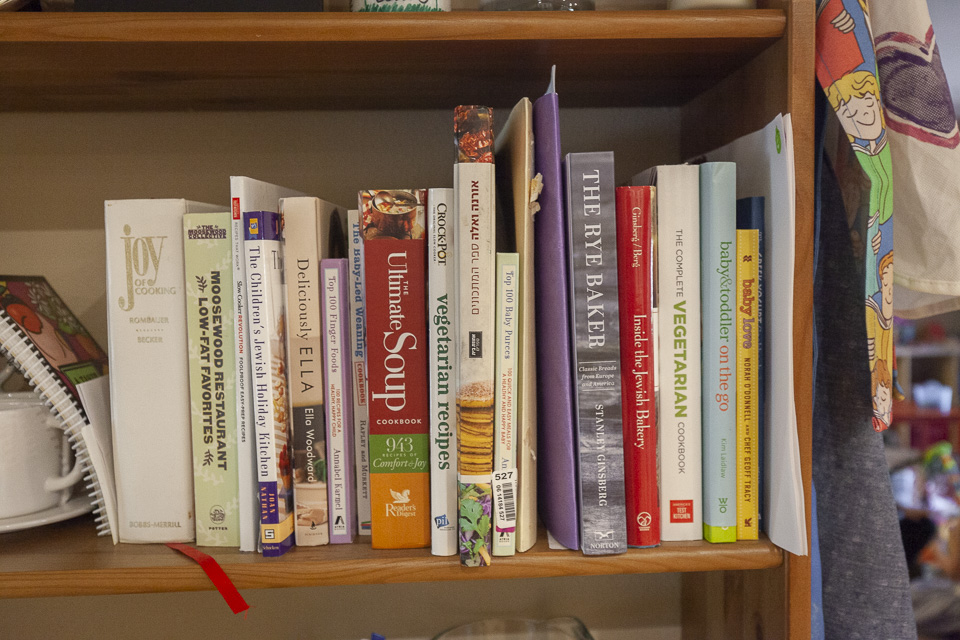
Ilana and Ben met at a conference in New Jersey and were both surprised to meet each other at something so mundane as a work conference. Ben is a Houston native, and around 5 years ago, together with Ben’s doggo Sandy, they all moved to Austin where Ilana said, “life is just so good and easy.”
Who does the cooking? “We take turns,” Ben tells me, “Ilana does most of the vegetable cooking, and I might make chicken or fish. But she helps with the chicken dishes, also.”
Ilana agreed, “Yes, Ben does most of the meats and fish, but I kinda tackle the veggies. Part of the reason I chose to do the CSA was because it was a challenge. I get to know new things I wouldn’t normally. But to say we’re very adventurous would be a stretch. We mostly bake (roast) veggies in the oven.” Somehow we were managing to have a discussion about vegetables, but we quickly got sidetracked by Sam’s sudden bout of stranger-danger towards Scott, the JBG photographer that was along for the visit. Then Lev needed more snacks, and then there was a discussion about whether or not Sam needed a diaper change, and then a tangent about Sandy - the angelic and obviously old golden retriever that was slowly wagging at my feet. Multitasking is obviously a skill Ben and Ilana are practiced at, because while I was thinking about what it would be like to road trip with Sandy from New York to Austin, Ben suddenly got us back on track - “When the food’s that good, you don’t have to do much more than just roast it.”


Ilana: “Also, we have kids, so how much can we really do? The time just isn’t always there. We’re also working around a few food sensitivities, so we just try to keep the food very simple. We eat a lot of salads. Lots and lots of salads.” Ilana loves parsley and often puts a whole bunch in her salads- undoubtedly an influence from her experience growing up in the Middle East. When asked about her kids’ tolerance of JBG veggies, both Ben and Ilana chimed in that their kids, thankfully, aren’t super picky. “”We’re lucky - our kids love lentil soup and I can basically throw any vegetable in there - like the turnips.” Sam, the youngest just had his first introduction to solid foods (sweet potatoes - he wasn’t a fan), and in no time he’ll likely be eating lentil soup, too.
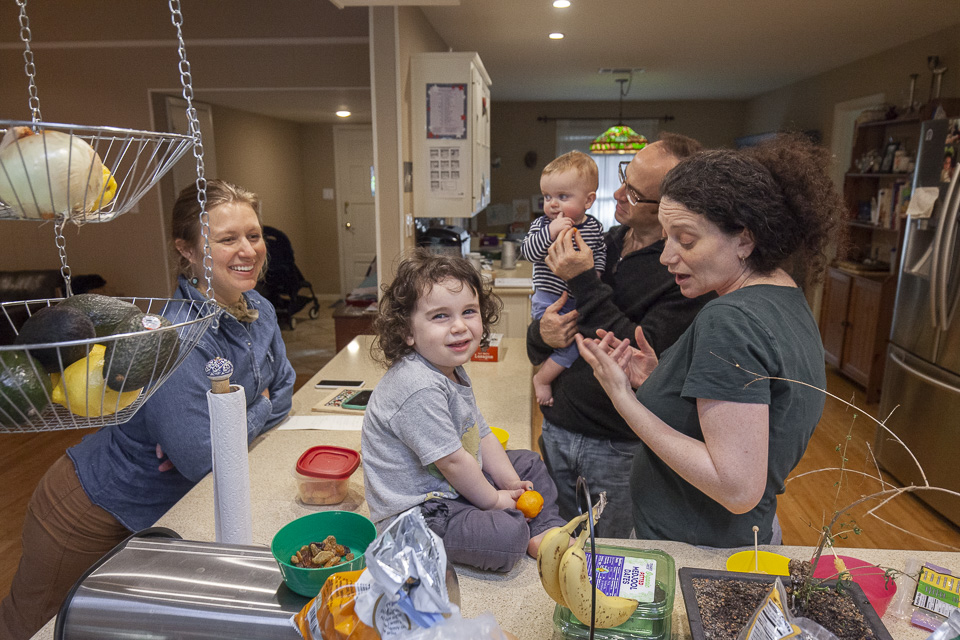
No matter how our members find their way to the farm, we're certainly glad they did. Ilana was introduced to the CSA through her membership at the JCC, which has been a JBG pickup location for over 10 years. When Lev (3) was born, the JCC offered a service where you could drop off your kiddo at a daycare for an hour or so to get in a quick workout at the community center’s gym. Thankfully for the farm, Ilana would most often find herself enjoying her hour of freedom reading a book in the center’s lobby… which is the drop location for our boxes each Thursday. “When I saw the boxes I just thought - this would be a good way to get more vegetables into our kitchen. And it did help! It actually, it really did help! Because there are all kinds of things, like kale, that I wouldn’t normally buy. Kale wasn’t really a big then where I grew up. I would never buy kale on my own. But now I have kale, and I just have to figure out something to to with kale.... But of course, especially with kale, sometimes it just doesn’t happen, and the kale, and collards, go home with the babysitter, Noa, for her to enjoy. And Kohlrabi! This is never something I would have bought. There’s actually this Israeli kids’ song with kohlrabi in it (the word is the same in Hebrew and English), and even though I’d heard of kohlrabi, I’d never actually seen it or cooked it.”
Discussions of kids’ songs lead to the origin story of the piano that sat in the space between the living room and kitchen, though really it’s all just one big homey space. The piano was Ben's grandmothers, and he is the musician in the house. Though there was a dedicated playroom, several toys trickled into the living room, and you could imagine a really fun existence in this home. No one was that concerned about the play trail, and Ilana gracefully navigated Lev’s very specific opinions and feelings about how he wanted his mango to be peeled (or not peeled?).
The whole Brown gang - Rosie, Lev, Ilana, and Ben with Sam in tow, and even the babysitter, Noa, who seemed to be part-family, made their way outside. Sandy, the golden retriever, walked very slowly and everyone cheered her on. Scott and I followed and we finished up our visit with a family portrait session. We visited the Browns at the beginning of February and had plans to share this spotlight shortly thereafter. But of course, the world (and our blog schedule) got turned on its head.

We’re happy to say that the Browns are all doing well - spending lots of time at home, “with what is now the new normal… which also means a lot more home cooking. We’re loving your boxes even more :).” And with that, we love you even more, Browns, and all the CSA members and member families who are spending time in the kitchen with our vegetables. We hope you feel the love we are putting into each and every CSA share and we hope you are cooking up some delicious home cooked meals. Stay well!
 Thank you, Browns, for letting us in to your home! We loved meeting you!
Thank you, Browns, for letting us in to your home! We loved meeting you!
CSA BOX CONTENTS WEEK OF APR 20TH
04/21/20 — Scott
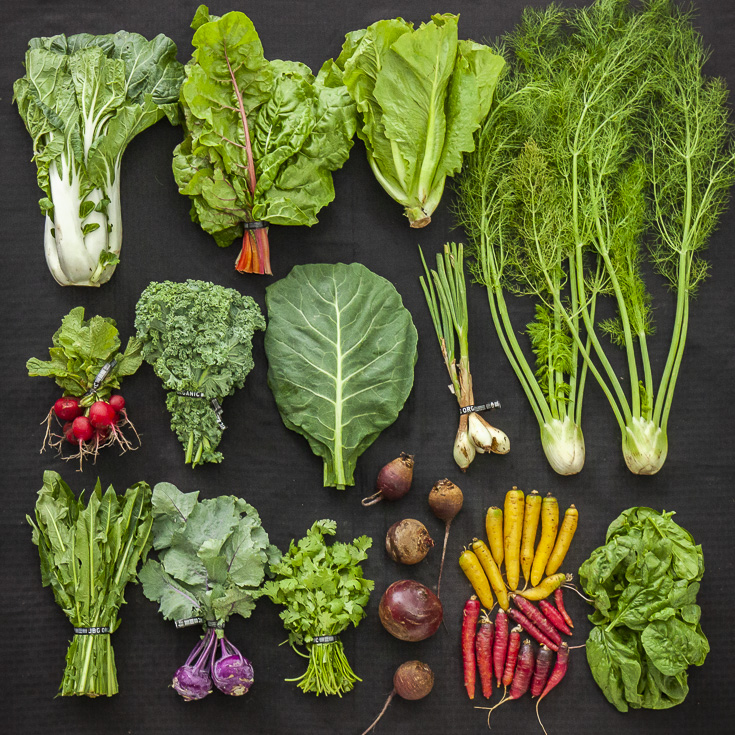 CSA Box Contents Week of Apr 20th
CSA Box Contents Week of Apr 20th
Large Box
Beets
Bok Choy
Carrots
Farmers Choice
Greens, Collards
Greens, Kale, Dino
Greens, Spinach
Herb, Cilantro
Herb, Fennel
Lettuce, Endive
Lettuce, Green Leaf
Onion, Spring Yellow
Radish
Beets
Bok Choy
Carrots
Farmers Choice
Greens, Collards
Greens, Kale, Dino
Greens, Spinach
Herb, Cilantro
Herb, Fennel
Lettuce, Endive
Lettuce, Green Leaf
Onion, Spring Yellow
Radish
Medium Box
Beets
Carrots
Farmers Choice
Greens, Collards
Greens, Kale, Dino
Greens, Spinach
Herb, Fennel
Lettuce, Endive
Lettuce, Green Leaf
Onion, Spring Yellow
Beets
Carrots
Farmers Choice
Greens, Collards
Greens, Kale, Dino
Greens, Spinach
Herb, Fennel
Lettuce, Endive
Lettuce, Green Leaf
Onion, Spring Yellow
Small Box
Bok Choy
Carrots
Greens, Chard, Rainbow
Lettuce, Endive
Lettuce, Romaine
Onion, Spring Yellow
Radish
Bok Choy
Carrots
Greens, Chard, Rainbow
Lettuce, Endive
Lettuce, Romaine
Onion, Spring Yellow
Radish
Individual Box
Bok Choy
Carrots
Greens, Kale, Curly
Greens, Spinach
Radish
Bok Choy
Carrots
Greens, Kale, Curly
Greens, Spinach
Radish
CSA BOX CONTENTS WEEK OF APR 20TH
04/22/20 — Scott
 CSA Box Contents Week of Apr 20th
CSA Box Contents Week of Apr 20th
Large Box
Beets
Bok Choy
Carrots
Greens, Collards
Greens, Kale, Curly
Greens, Spinach
Herb, Cilantro
Herb, Fennel
Kohlrabi, Purple
Lettuce, Endive
Lettuce, Romaine
Onion, Spring Yellow
MOROCCAN CARROT AND KALE COUSCOUS SALAD
04/22/20 — Ada Broussard
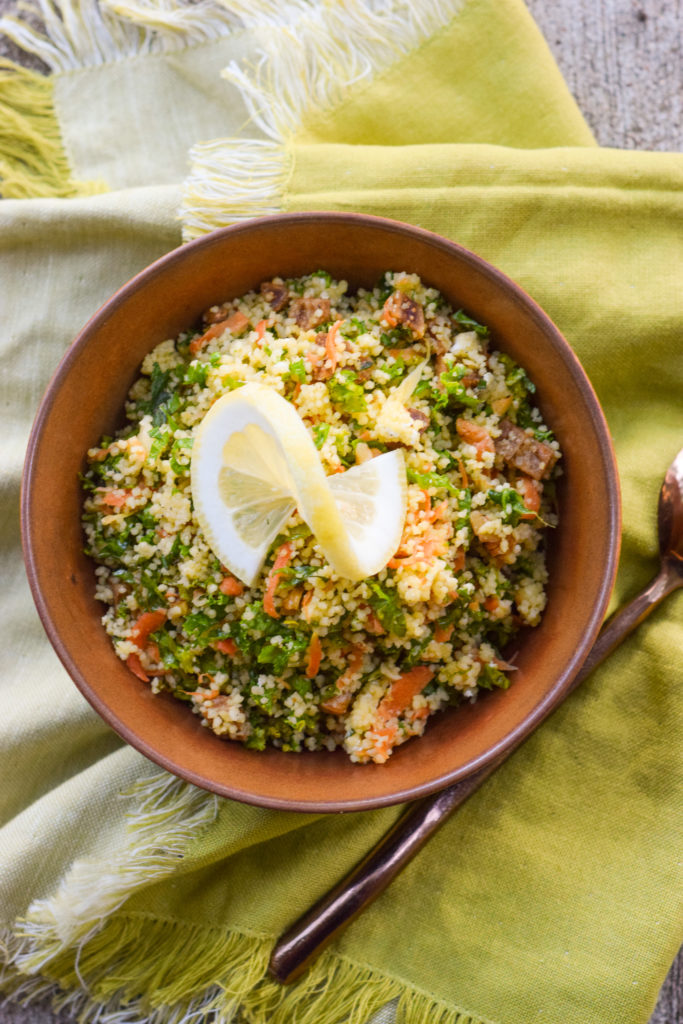
Servings: 4 Author: www.themigonikitchen.com
During my college years, I was fortunate enough to spend 3 weeks in Morocco for a travel term with the sweetest host family. They prepared traditional Moroccan food for me every night, and it really opened my eyes to this unique cuisine. Before visiting, I thought Moroccan food would be similar to other Middle Eastern and Mediterranean dishes, but the flavor profiles are truly unique to Morocco. I’ve tried to bring back those flavors to my own kitchen, and it can be admittedly hard as some of these ingredients are hard to find, but I always enjoy even little remnants of those Moroccan dishes.
This couscous salad is in no way authentic, but the flavors and textures bring me back to that trip. If you have not had the pleasure of experimenting with Moroccan recipes, I highly recommend checking some out.
For this particular recipe, we used some grated carrots, finely chopped kale and mint. It should go without saying that you can use other greens you have on hand like spinach or arugula. The same goes for the herbs – cilantro or parsley would be good alternatives if you don’t have mint on hand.
In keeping with Moroccan textures, we added in some dried figs for a little sweetness. You can use raisins, dried cranberries, or dried apricots as alternatives. We also added in some chopped walnuts for some crunch. Again, you could use almonds or other nuts instead. We just used what we had on hand in the pantry. Lastly, we added a little bit of goat cheese for a touch of creaminess. If you have feta, this would be ideal.
Ingredients: Couscous Salad
- 1 Cup Carrots Grated
- 2 Cups Kale Finely Chopped
- 1/4 Fresh Mint Finely Chopped; can sub parsley or cilantro
- ½ Cup Walnuts Chopped
- ½ Cup Dried Figs Or other dried fruit, chopped
- ½ Cup Goat Cheese Such as Feta
- 1 Cup Dried Couscous Cooked according to package instructions and cooled
Dressing - 3 Tablespoons Olive Oil
- 2 Tablespoons Honey
- 1 Lemon Juiced
- ½ Teaspoon Kosher Salt
- ½ Teaspoon Black Pepper
- ¼ Teaspoon Garlic Powder
Combine all the ingredients for the dressing and whisk together in a small bowl. Set aside. Combine the cooled couscous with the remainder of the salad ingredients and toss to mix well. Pour the dressing over and toss once more to combine. Serve immediately or refrigerate until ready to serve.
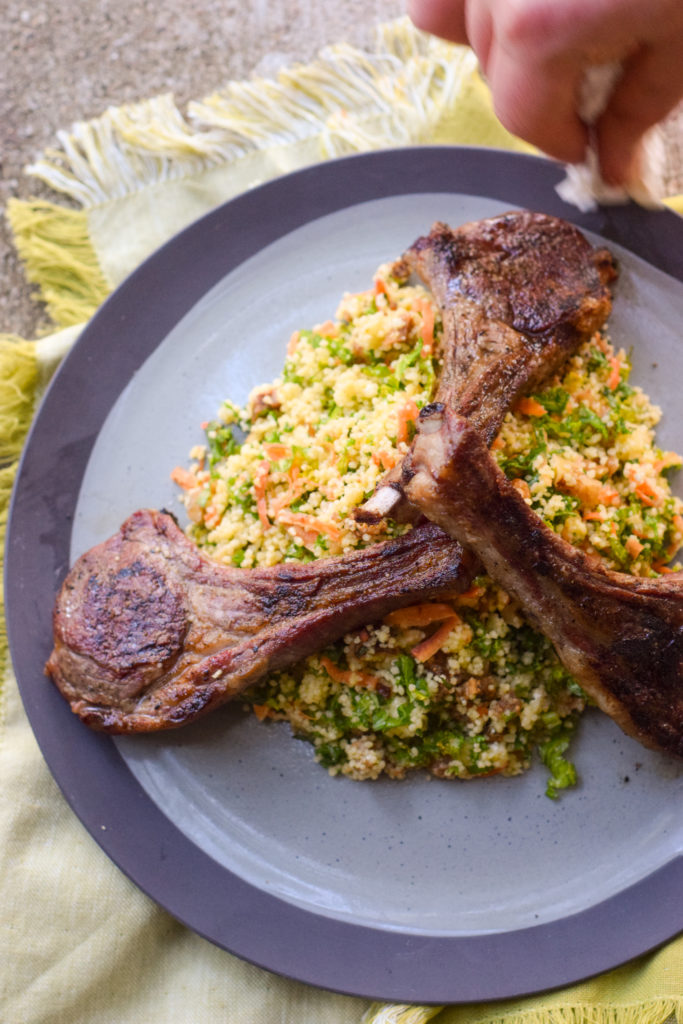
PHOTOS FROM THE FARM: 4.24.20
04/24/20 — Ada Broussard
How are you spending your time these days? For us, it's rows of carrots, potato flowers, and endless harvest schedules. Scott's trip out to the farm this week caught all the action typical of a JBG spring.
![]() Beloved box truck # 3. She's been with us for a long time, hence the need for a paint-touch up. But really, we kinda like her just the way she is. You? Photo by Scott David Gordon.
Beloved box truck # 3. She's been with us for a long time, hence the need for a paint-touch up. But really, we kinda like her just the way she is. You? Photo by Scott David Gordon.
![]() We heard you guys like carrots, so we planted a few more. Photo by Scott David Gordon.
We heard you guys like carrots, so we planted a few more. Photo by Scott David Gordon.
![]() These heads of romaine are sizing up. Coming to a CSA box near you, soon. Photo by Scott David Gordon.
These heads of romaine are sizing up. Coming to a CSA box near you, soon. Photo by Scott David Gordon.
![]() Luke, who joined our crew this past fall from a farm in Vermont, power washing the green picker in preparation for a harvest in a few weeks. Photo by Scott David Gordon.
Luke, who joined our crew this past fall from a farm in Vermont, power washing the green picker in preparation for a harvest in a few weeks. Photo by Scott David Gordon.
![]() New gravel on an old road. Photo by Scott David Gordon.
New gravel on an old road. Photo by Scott David Gordon.
![]() The appearance of flowers on our potato plants indicates the end of their growing season.... which is a good thing! Because that means it's almost time to uproot these green plants and dig ourselves some potatoes! Photo by Scott David Gordon.
The appearance of flowers on our potato plants indicates the end of their growing season.... which is a good thing! Because that means it's almost time to uproot these green plants and dig ourselves some potatoes! Photo by Scott David Gordon.
![]() Could these colors be any more electric? Photo by Scott David Gordon.
Could these colors be any more electric? Photo by Scott David Gordon.
![]() You don't have to look hard to find a reason to love chard.... Photo by Scott David Gordon.
You don't have to look hard to find a reason to love chard.... Photo by Scott David Gordon.
![]() Our chard plants love this warmer weather and the leaves size up to monstrous proportions - perfect for using like a tortilla for chard enchiladas. Photo by Scott David Gordon.
Our chard plants love this warmer weather and the leaves size up to monstrous proportions - perfect for using like a tortilla for chard enchiladas. Photo by Scott David Gordon.
![]() Just a few short weeks ago every inch of this greenhouse was covered with spring plants. Now, most of these are in the ground and there are only clues to their previous home. Photo by Scott David Gordon.
Just a few short weeks ago every inch of this greenhouse was covered with spring plants. Now, most of these are in the ground and there are only clues to their previous home. Photo by Scott David Gordon.
![]() Lots of green, and a bit of red, leaf lettuce. Photo by Scott David Gordon.
Lots of green, and a bit of red, leaf lettuce. Photo by Scott David Gordon.
![]() If harvesting beets don't bring you joy, you're not doing it right. Photo by Scott David Gordon.
If harvesting beets don't bring you joy, you're not doing it right. Photo by Scott David Gordon.
![]() A farm in thirds: dandelion, tractor, Texas sky. Photo by Scott David Gordon.
A farm in thirds: dandelion, tractor, Texas sky. Photo by Scott David Gordon.
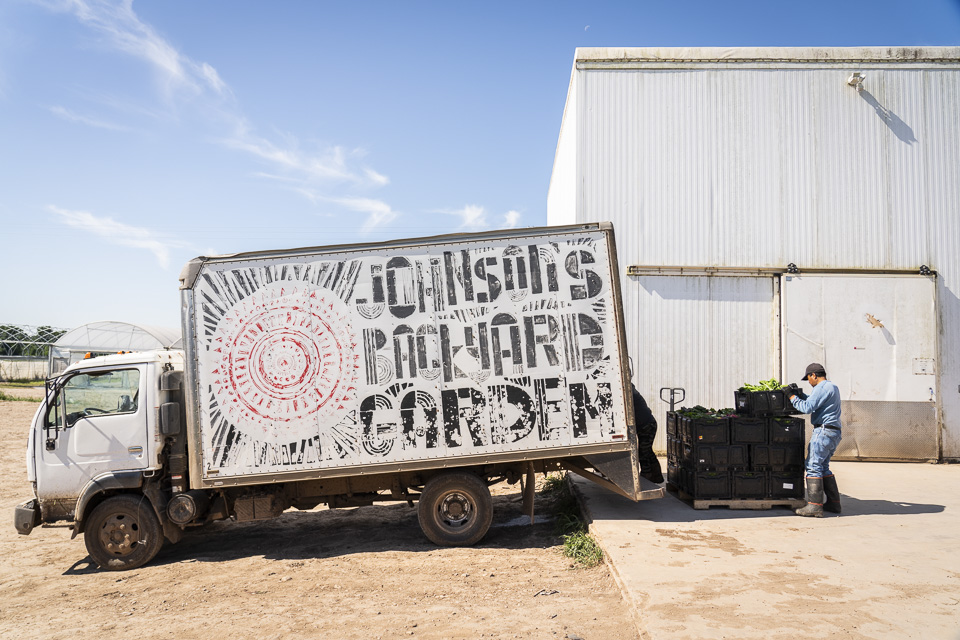 Beloved box truck # 3. She's been with us for a long time, hence the need for a paint-touch up. But really, we kinda like her just the way she is. You? Photo by Scott David Gordon.
Beloved box truck # 3. She's been with us for a long time, hence the need for a paint-touch up. But really, we kinda like her just the way she is. You? Photo by Scott David Gordon.
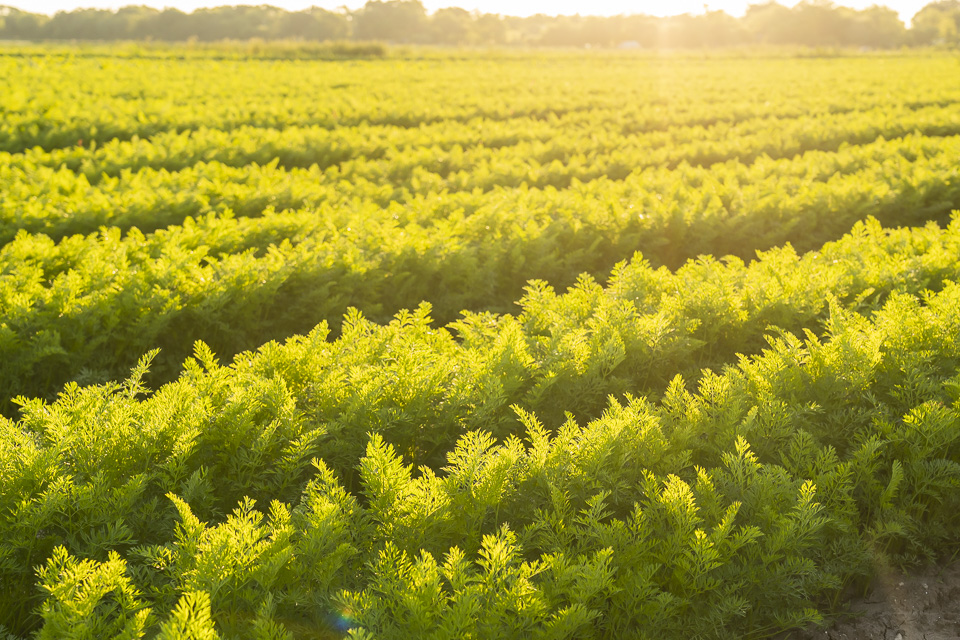 We heard you guys like carrots, so we planted a few more. Photo by Scott David Gordon.
We heard you guys like carrots, so we planted a few more. Photo by Scott David Gordon.
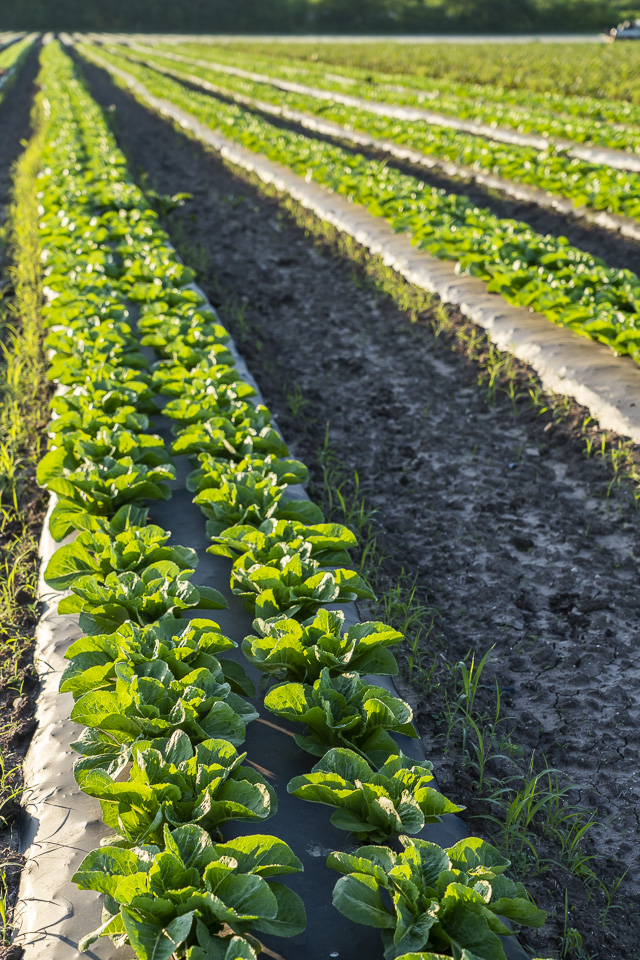 These heads of romaine are sizing up. Coming to a CSA box near you, soon. Photo by Scott David Gordon.
These heads of romaine are sizing up. Coming to a CSA box near you, soon. Photo by Scott David Gordon.
 Luke, who joined our crew this past fall from a farm in Vermont, power washing the green picker in preparation for a harvest in a few weeks. Photo by Scott David Gordon.
Luke, who joined our crew this past fall from a farm in Vermont, power washing the green picker in preparation for a harvest in a few weeks. Photo by Scott David Gordon.
 New gravel on an old road. Photo by Scott David Gordon.
New gravel on an old road. Photo by Scott David Gordon.
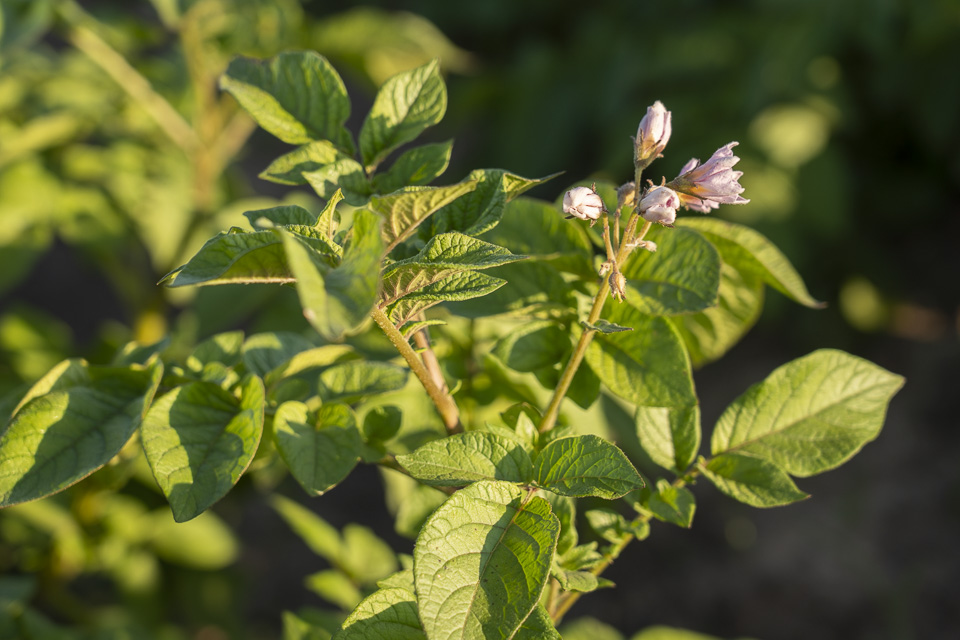 The appearance of flowers on our potato plants indicates the end of their growing season.... which is a good thing! Because that means it's almost time to uproot these green plants and dig ourselves some potatoes! Photo by Scott David Gordon.
The appearance of flowers on our potato plants indicates the end of their growing season.... which is a good thing! Because that means it's almost time to uproot these green plants and dig ourselves some potatoes! Photo by Scott David Gordon.
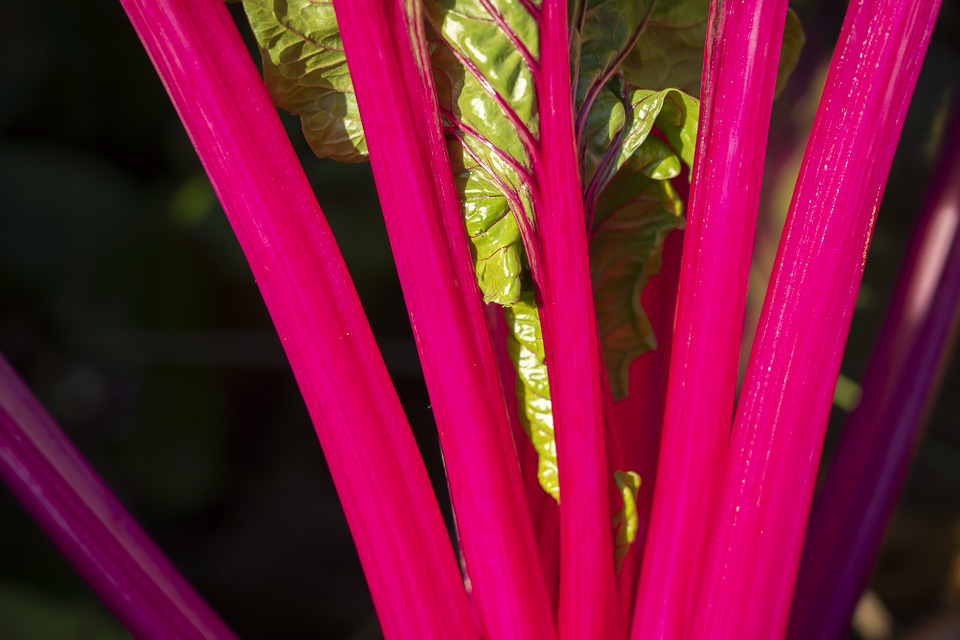 Could these colors be any more electric? Photo by Scott David Gordon.
Could these colors be any more electric? Photo by Scott David Gordon.
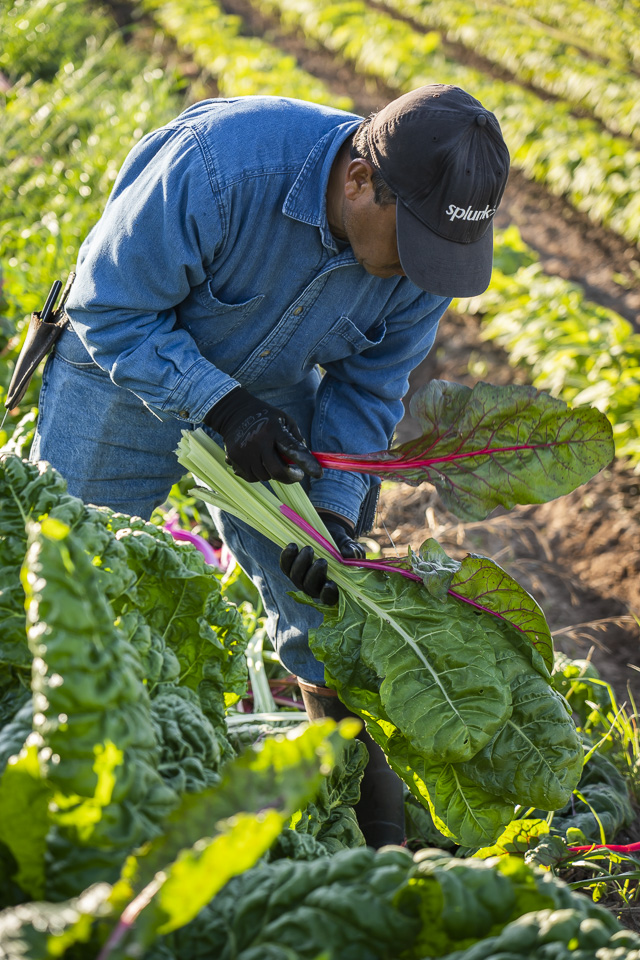 You don't have to look hard to find a reason to love chard.... Photo by Scott David Gordon.
You don't have to look hard to find a reason to love chard.... Photo by Scott David Gordon.
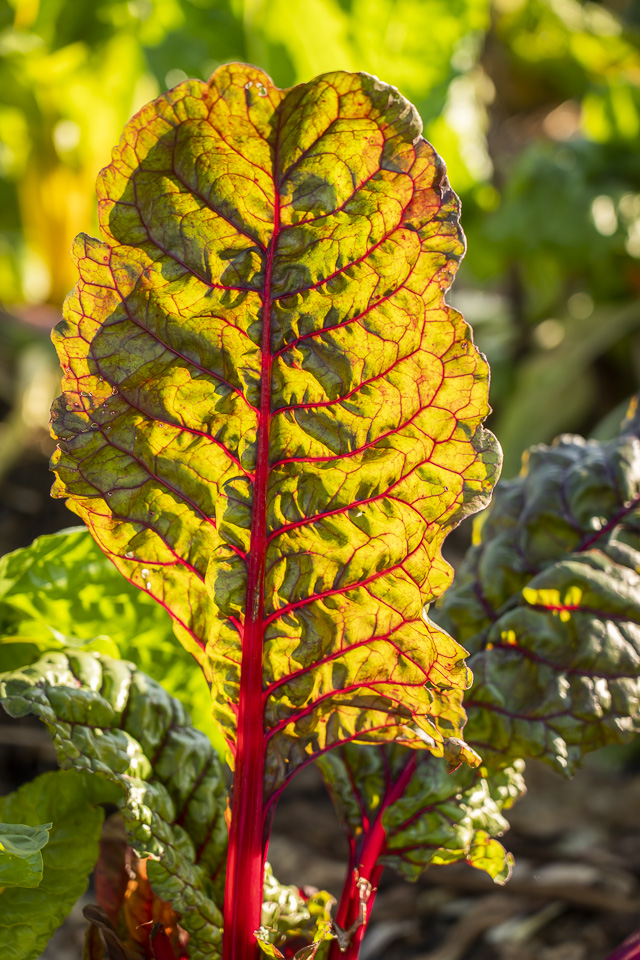 Our chard plants love this warmer weather and the leaves size up to monstrous proportions - perfect for using like a tortilla for chard enchiladas. Photo by Scott David Gordon.
Our chard plants love this warmer weather and the leaves size up to monstrous proportions - perfect for using like a tortilla for chard enchiladas. Photo by Scott David Gordon.
 Just a few short weeks ago every inch of this greenhouse was covered with spring plants. Now, most of these are in the ground and there are only clues to their previous home. Photo by Scott David Gordon.
Just a few short weeks ago every inch of this greenhouse was covered with spring plants. Now, most of these are in the ground and there are only clues to their previous home. Photo by Scott David Gordon.
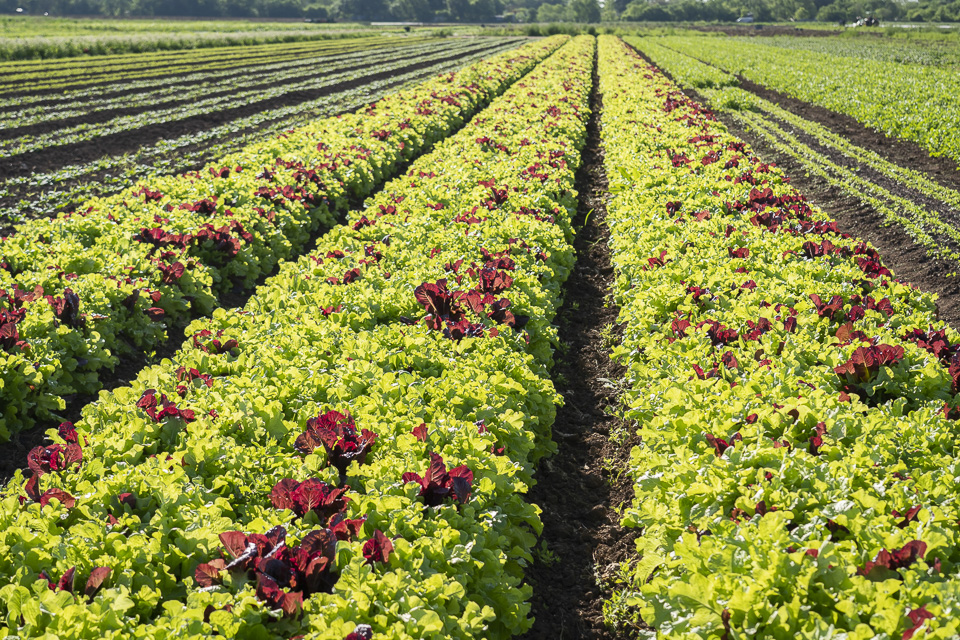 Lots of green, and a bit of red, leaf lettuce. Photo by Scott David Gordon.
Lots of green, and a bit of red, leaf lettuce. Photo by Scott David Gordon.
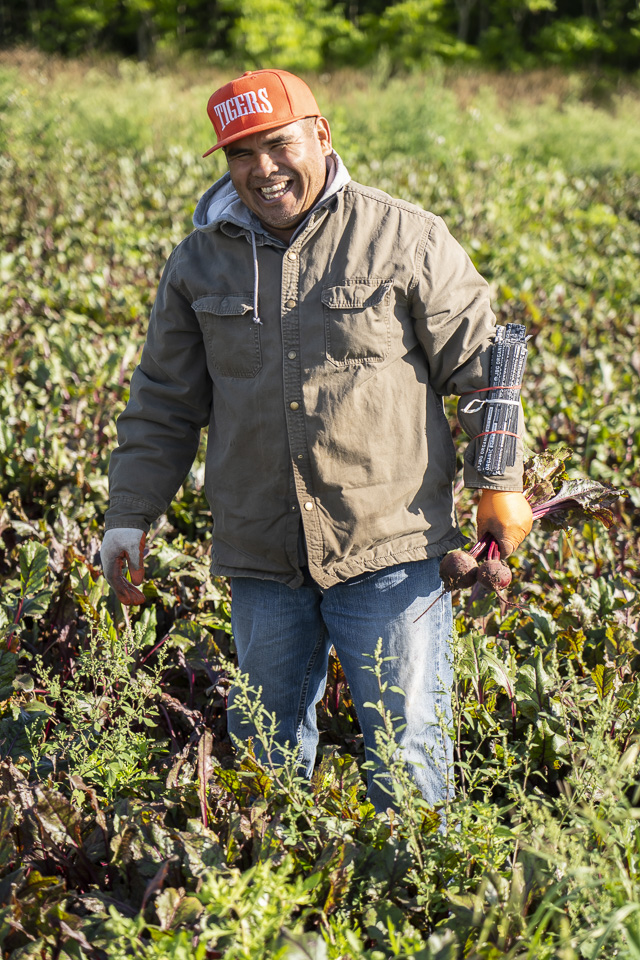 If harvesting beets don't bring you joy, you're not doing it right. Photo by Scott David Gordon.
If harvesting beets don't bring you joy, you're not doing it right. Photo by Scott David Gordon.
 A farm in thirds: dandelion, tractor, Texas sky. Photo by Scott David Gordon.
A farm in thirds: dandelion, tractor, Texas sky. Photo by Scott David Gordon.
45 RECIPES, STRAIGHT FROM OUR COMMUNITY VIA THE WIDE WORLD OF INSTAGRAM
04/24/20 — Ada Broussard

Pictures are worth a thousand words, and it seems like you guys, our wonderful farm community, have uploaded thousands of beautiful photos of what you're cooking lately. We went to Instagram and pulled 45 community-submitted photos that have been posted in the past couple of weeks. Scroll through the photos and photo descriptions below to see what everyone is making - perhaps it will help inspire you're weekend plans! And please, keep these submissions coming! Not only are they helpful for fellow farm-followers to see, but they are also wonderful for the farm staff to see... we love how you transform our veggies into drool-worthy plates. And if you're not on Instagram, feel free to submit recipes directly to Ada: ada@jbgorganic.com. Oh! And one of our CSA Members, Ashley Franklin, shared this wonderful illustration on Instagram. It's not a recipe, but it's too cute not to share. See more of Ashley's wonderful work on her website or Instagram .
If you're looking to up your food-inspiration on Instagram, perhaps you could start by checking out some of these accounts: real people, cooking the same seasonal ingredients that are landing in your CSA shares or market hauls. Keep on, and keep cookin'!

- @seasonal.ish : Carrot top pesto! The recipe is posted on this original post as well as on the JBG website - just search "carrot top pesto" in our search bar and you'll find it.
- @cityofthevioletcrown : "Thank goodness for farmer's markets and JBG! Did you know only 1% of food consumed in Austin is sourced locally?"
- @themigonikitchen : Moroccan Carrot and Kale Couscous Salad. Lucky for you, this complete recipe is featured on the blog today!
- @rollsriceforever : The makings of some wonderful spring rolls featuring JBG beets and herbs. Make yourself, or simply order these rolls directly from Rolls Rice Forever.
- @carlyloveskale : Seasonal salad with homemade dressing made of apple cider vinegar, olive oil, mustard, and salt.
- @sierralashofficial : The most comforting bowl of minestrone soup. Checkout the original post for the recipe!
- @dakotameurer : Traditional golumpki... aka, cabbage rolls! We're interested!
- @eatingwelle : Spaghetti squash chap chae. Yep.
- @barenutritionalhealth : A very nutritional bowl featuring a homemade veggie burger patty and herbed salad. Perfect lunch combo.

10. @c_leemonsta : This lady locavore made a delicious bowl of roasted Brussels sprouts and beets.. topped with Yellowbird siracha.
11. @squabletime : This Houston restaurant made Sardinian-style gnocchi featuring Caprafoods lamb and JBG carrots. Let this dish be your compass. Or, simply order for curbside.
12. @rollsriceforever : This Austin-based company is at it again with beautiful spring rolls.
13. @browngalbakes : Roasted JBG carrots and blood oranges, laid to rest in a bed of za'atar and tahini. Another Allison Roman home-run.
14. @browngalbakes : (She's been busy!) Squash, mushroom, and carrot greens with a garlic-y, lemony-y za'atr yogurt magic on the side.
15. @mackannecheese : Allison Roman's "the stew" made better by cheetos. And loads of JBG veggies.
16. @aimeeatx : Jingalov hats - greens-stuffed Armenian flatbread stuffed with beet greens, spinach, parsley, carrot tops, onions, and carrots. garlicky yogurt on the side for dipping!
17. @wholesomefoodjourney : Homemade tortillas topped with Okinawa potatoes, homemade seitan and greens. Checkout t his account for, as the name, a journey into wholesome food!
18. @christineterrell : "Spent the morning pesto-izing all the fresh greens we were in no way going to get to eat fresh. Gotta get my CSA legs under me."

19. @satoriahost : A beautiful rainbow chard and queso fresco situation. Checkout the original post for the recipe!
20. @clubhomemade : Miso glazed turnips, which is maybe the best way to cure any potential turnip-fatigue. Recipe on the JBG blog - just use the search bar!
21. @foodsoph : A dish, and a poem: "Polenta, sauteed chard, (veggie) Itialn sausage, pickled radishes. Pitter patter rain. Whiskey sour. Quarantine."
22. @katnprat : "One month into #quarantinelife, and now i know what beet, blueberry and oat muffins taste like. #realgood"
23. @aargersi : "Castoff sourdough pizza crust + csa = lemony swiss chard, carmalized onion and ricotta pizza."
24. @chelsea.hutchens : Schwarma-spiced beets and cauliflower, served with garlic-y labneh.
25. @seasonal.ish : "Sour cream and onion biscuits - goodies you can make from last week's CSA box if you have sour cream, flour, and butter!"
26. @laurel_wilson923 : "This was AMAZING!!!! Rice noodles tossed with hoisin, leftover San Bai Zu, and leftover Yuzu Pon (from Uchi cookbook)... Spring onions and cilantro from JBG Organic."
27. @sierralashofficial : Big bowl of comfort = homemade matzo ball soup. Checkout Sierra's page for the full matzo ball soup recipe!

28. @sewknitter : Za'atar (which seems to be a thing this quarantine!) topped roasted carrots with chickpeas and yogurt. Scroll on the original post to see the tantalizing reverse-seared rib-eye steaks.
29. @aargersi : "Beets with mint and lime yogurt. Eat the rainbow!"
30. @laurel_wilson923 : Red lentil soup featuring JBG carrots, kale, cilantro, and spring onions.
31. @laurelizsp : "I'm typically anti-anise but the warm spices work well with the sweetness of the golen beets. Are dessert pickles a thing? Anyway..."
32. @mojoquix : Torta de carote (Italian carrot cake)... featuring JBG carrots and Barton Springs Mill flour, so you know it was good.
33. @hifimyco : "Shoyu pork bone broth ramen #stayhomeedition."
34. @themigonikitchen : Baked fried chicken served with braised JBG collard greens. And cornbread, because duh.
35. @foxxotron : Collard green wraps with marinated jackfruit and JBG veggies.
36. @_worldinapocket : Chard-filled enchiladas with a secret carrot-filled sauce. Recipe coming to the JBG blog next week. Stay tuned!

37. @marthapincoffs : "Yesterday, I needed to clea out my veggies from last week and soup is a great way to do it. I developed extra flavor by roasting the veggies ahead of time."
38. @juanalbertorey : A "grateful for everything" quiche featuring JBG veggies and Whitehurst Farm eggs.
39. @lenoiratx : Roated and spiced Texas carrots with cardamom yogurt, herbs, and dukka - available from their Lenoir curbside menu if you need a break in the kitchen.
40. @makewithmadeline : Coconut carrot soup with lots of garlic and ginger for ultimate soupy vibes.
42. @clubhomemade : JBG Beet Hummus. Recipe on the JBG blog - search it up!
41. @biggals_kitchen : "How much time is too much time watching Bon Appetits test kitchen? Tonight I recreated Andy Baraghani's chicken stew with carmalized lemons. I served it over rice and braised (JBG) greens."
43. @mexicanity : A chickpea and veggie stew, perfect for then your next CSA box is on the way and there are still some lingering veggies. Full recipe on the original post.
44. @mackannecheese : A kale pesto, or sorts. Perfect for kale, or any green you might find. Recipe on the JBG blog - just use the search bar. 45. @justapinchaustin : Leftover Moroccan rice served over sauteed kale, chard, avocado, and chili crisps. "A perfect #meatless lunch option during the covid-19 quarantine. Or any time."
CSA BOX CONTENTS WEEK OF APR 27TH
04/27/20 — Scott
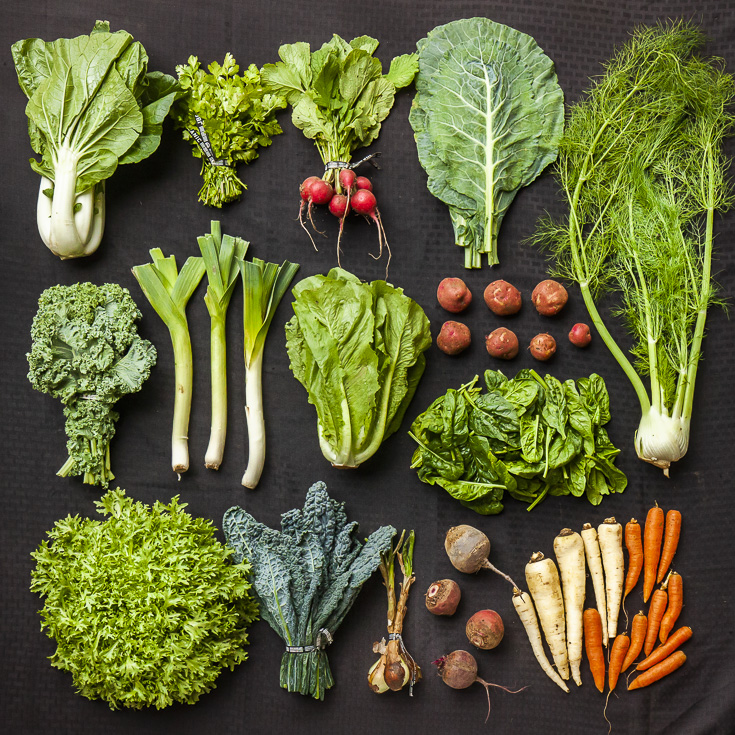 CSA Box Contents Week of Apr 27th
CSA Box Contents Week of Apr 27th
Large Box
Beet, Golden
Bok Choy
Carrots
Farmers Choice
Greens, Chard, Rainbow
Herb, Farmers Choice
Herb, Farmers Choice
Leek
Lettuce, Braising Mix
Lettuce, Green Leaf
Potato
Radish
Beet, Golden
Bok Choy
Carrots
Farmers Choice
Greens, Chard, Rainbow
Herb, Farmers Choice
Herb, Farmers Choice
Leek
Lettuce, Braising Mix
Lettuce, Green Leaf
Potato
Radish
Medium Box
Bok Choy
Carrots
Greens, Chard, Rainbow
Greens, Kale, Curly
Herb, Fennel
Leek
Lettuce, Green Leaf
Potato
Radish
Bok Choy
Carrots
Greens, Chard, Rainbow
Greens, Kale, Curly
Herb, Fennel
Leek
Lettuce, Green Leaf
Potato
Radish
Small Box
Beet, Golden
Greens, Collards
Greens, Kale, Curly
Herb, Fennel
Leek
Lettuce, Green Leaf
Potato
Beet, Golden
Greens, Collards
Greens, Kale, Curly
Herb, Fennel
Leek
Lettuce, Green Leaf
Potato
Individual Box
Bok Choy
Carrots
Greens, Collards
Herb, Farmers Choice
Herb, Farmers Choice
Herb, Fennel
Lettuce, Green Leaf
Bok Choy
Carrots
Greens, Collards
Herb, Farmers Choice
Herb, Farmers Choice
Herb, Fennel
Lettuce, Green Leaf
CSA BOX CONTENTS WEEK OF APR 27TH
04/28/20 — Scott
 CSA Box Contents Week of Apr 27th
CSA Box Contents Week of Apr 27th
Large Box
Beets
Bok Choy
Carrots
Farmers Choice
Greens, Collards
Greens, Kale, Curly
Greens, Kale, Dino
Greens, Spinach
Herb, Cilantro
Herb, Fennel
Lettuce, Endive
Lettuce, Romaine
Onion, Spring Yellow
Radish






 0 ITEMS IN CART
0 ITEMS IN CART 





